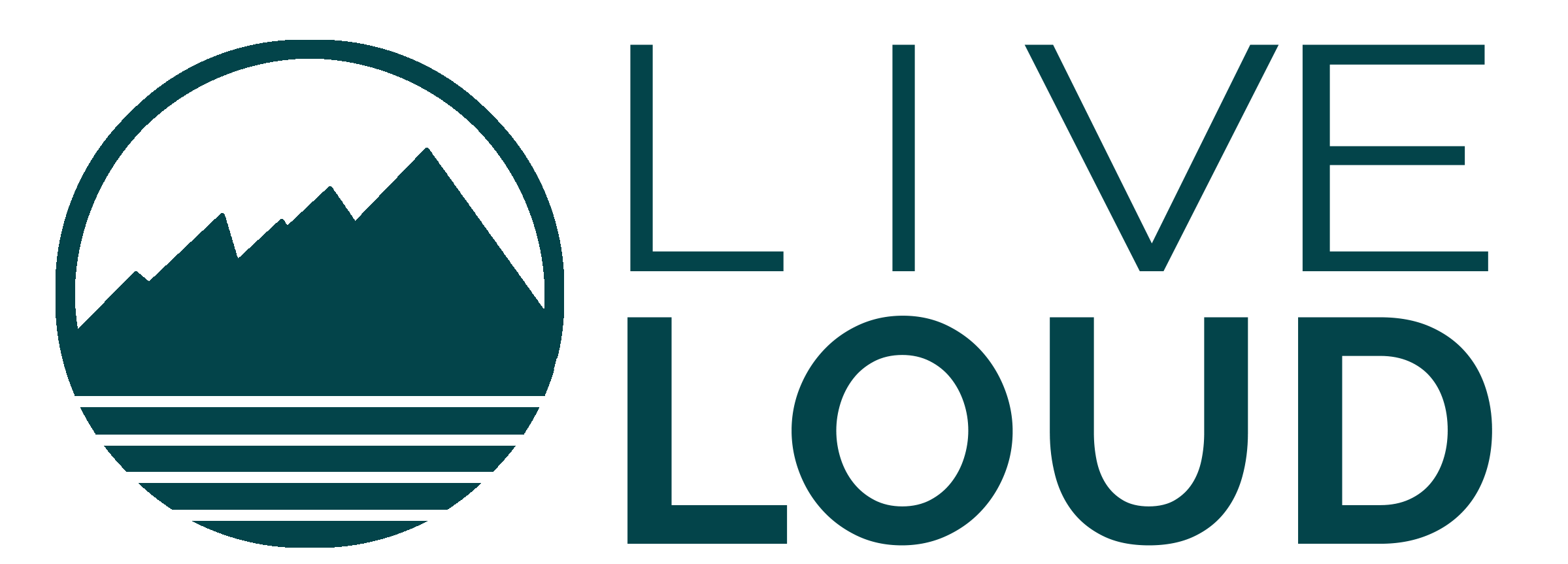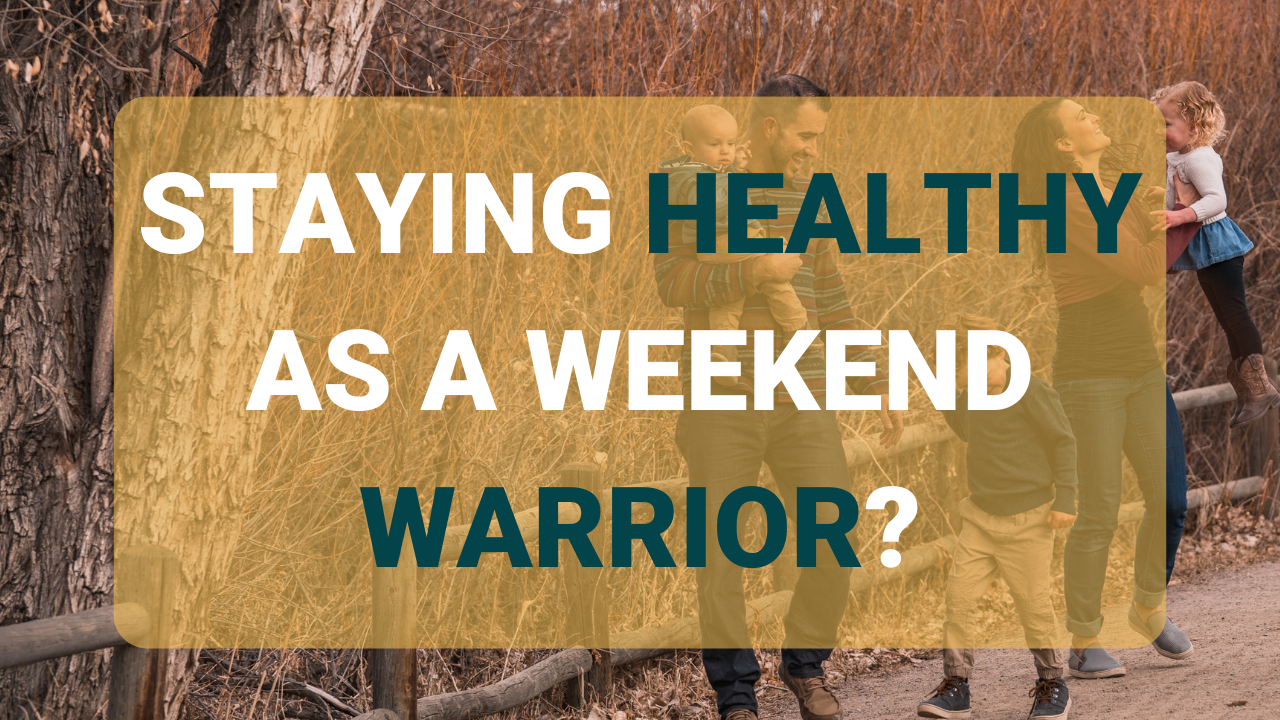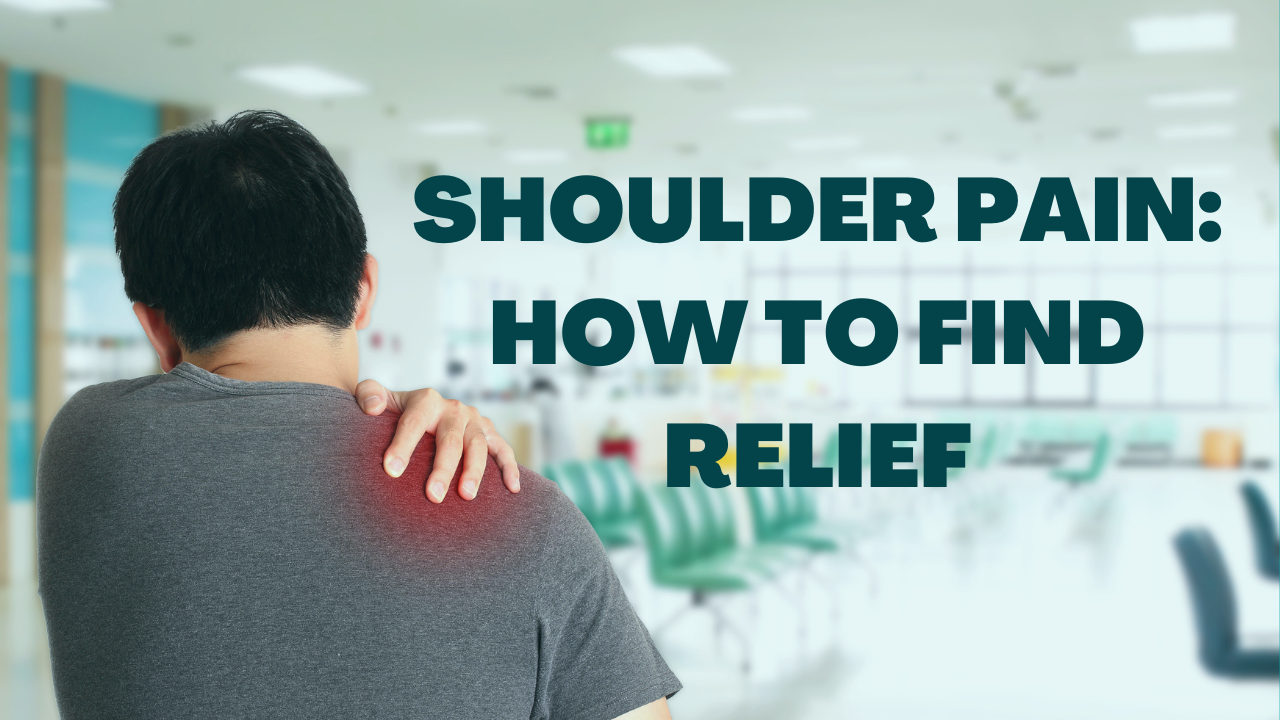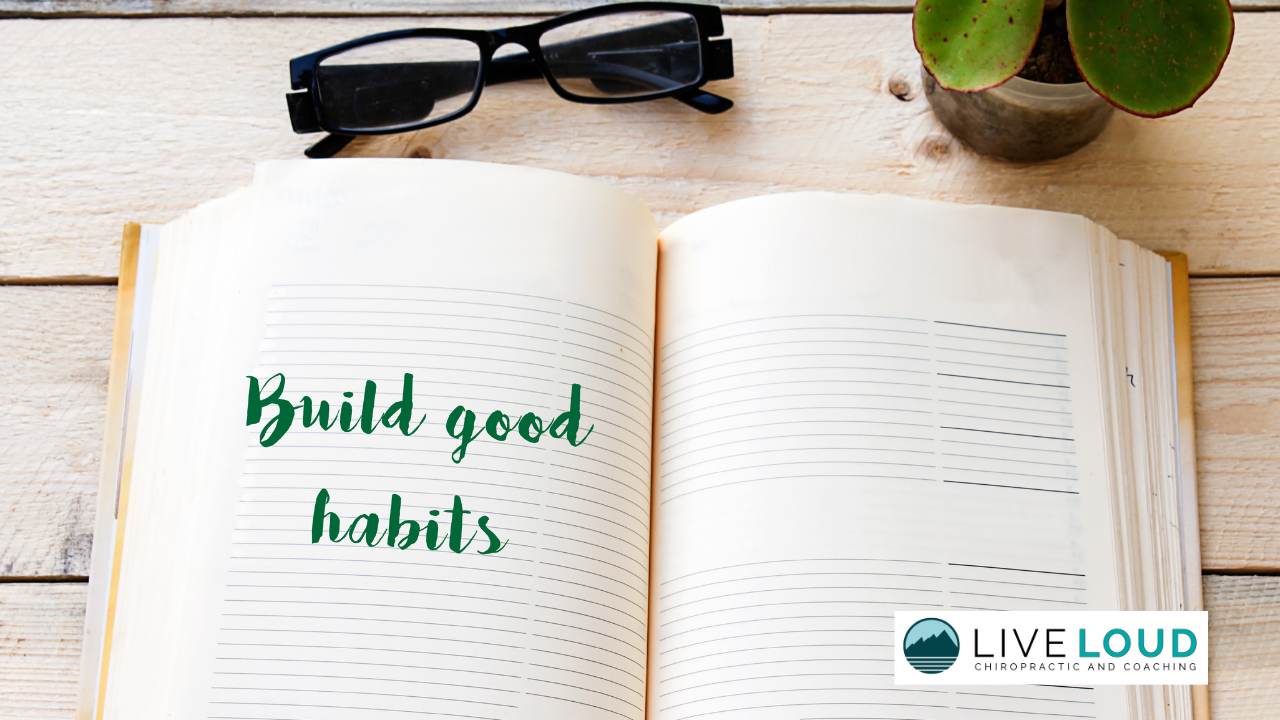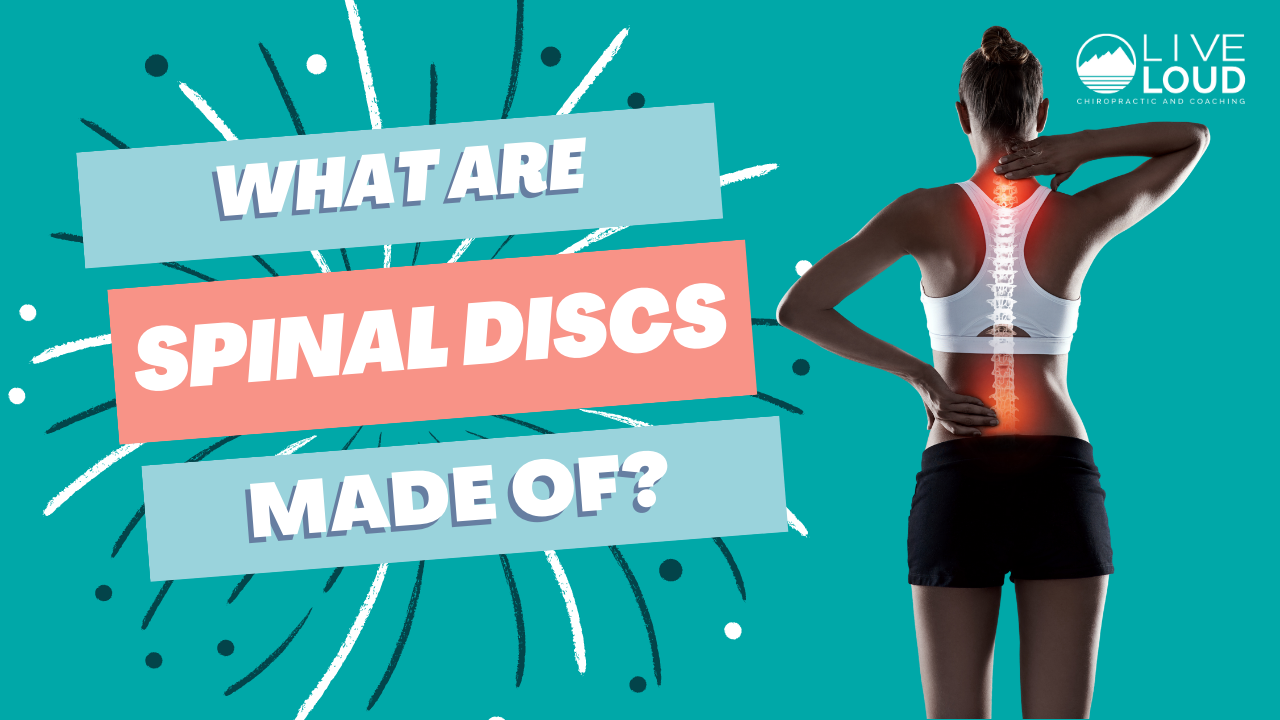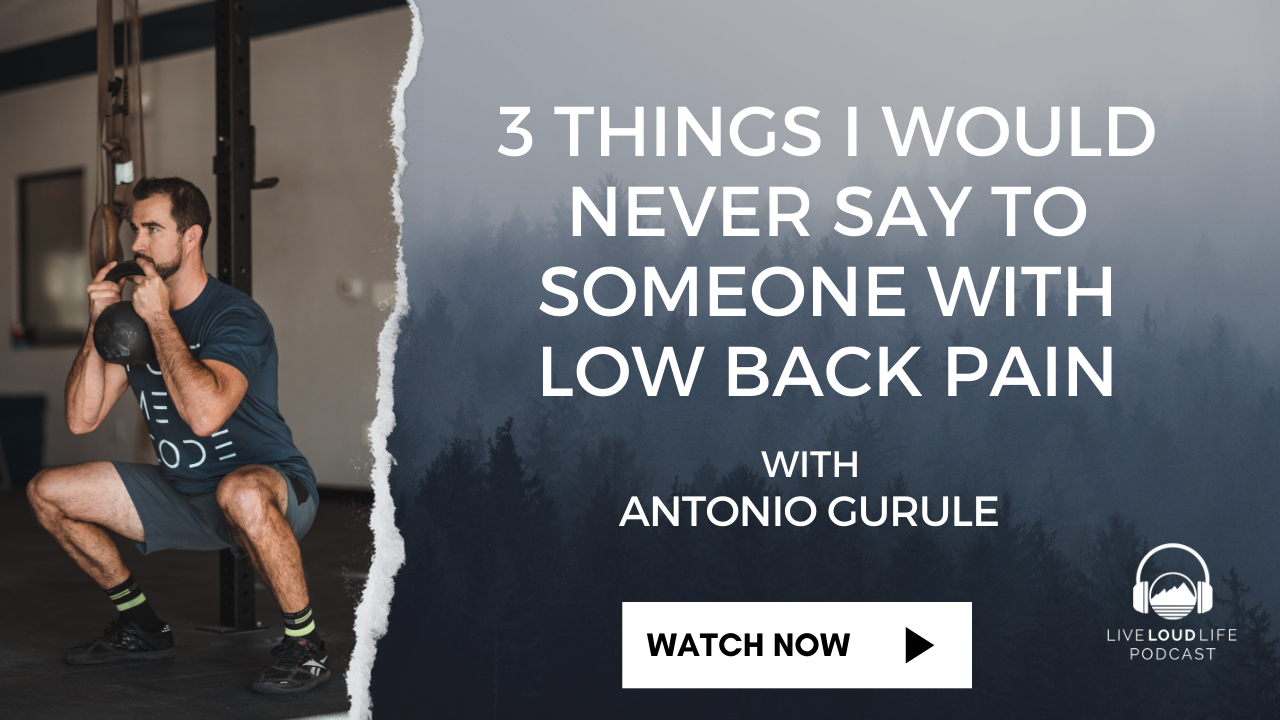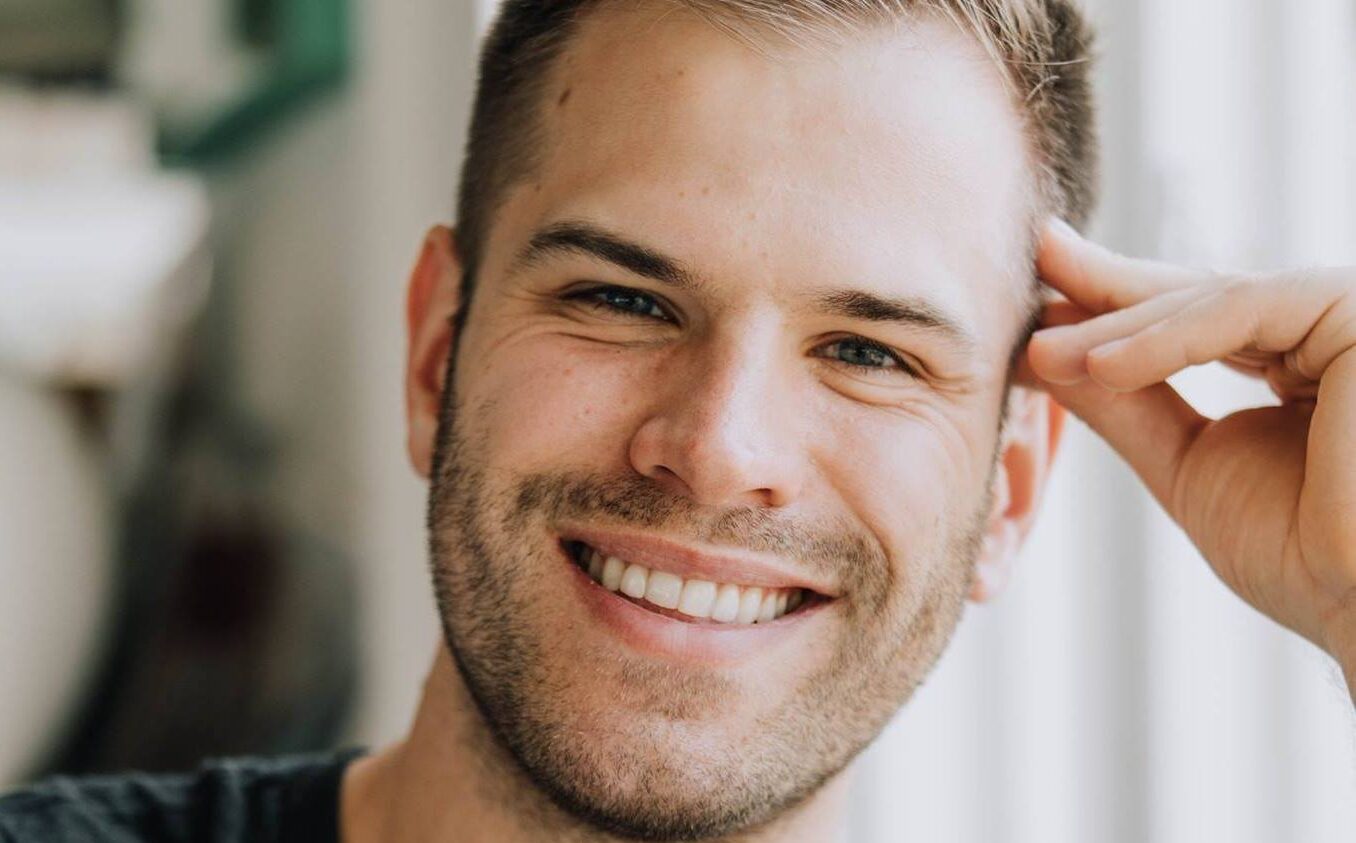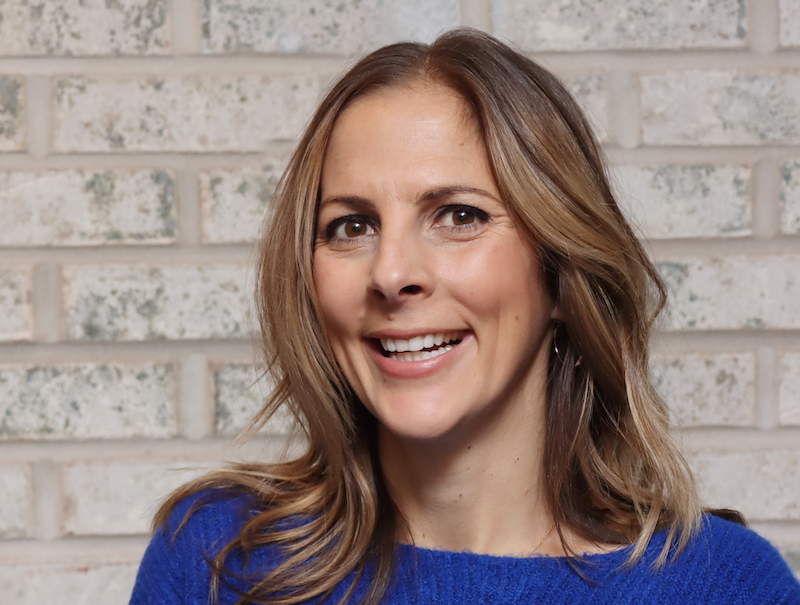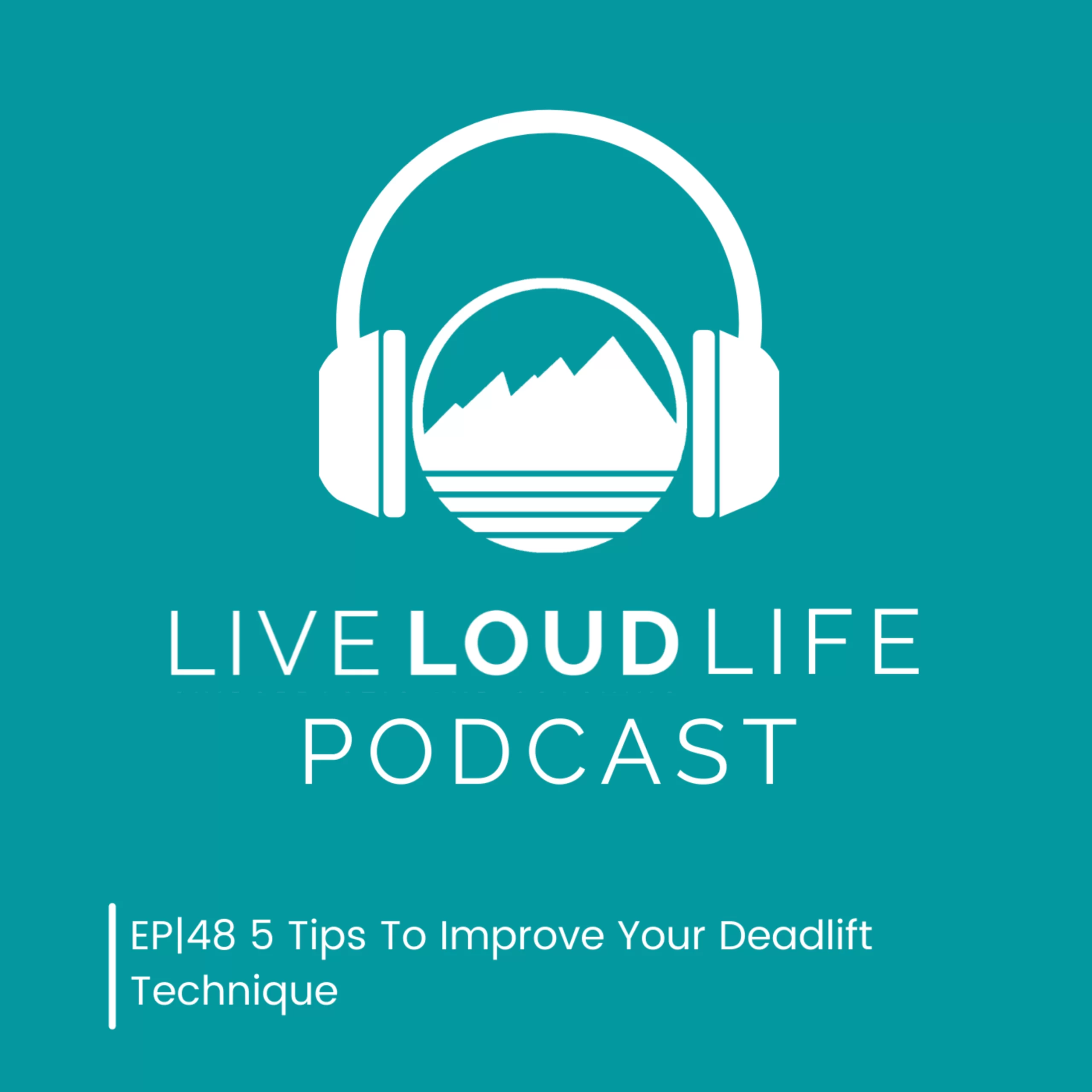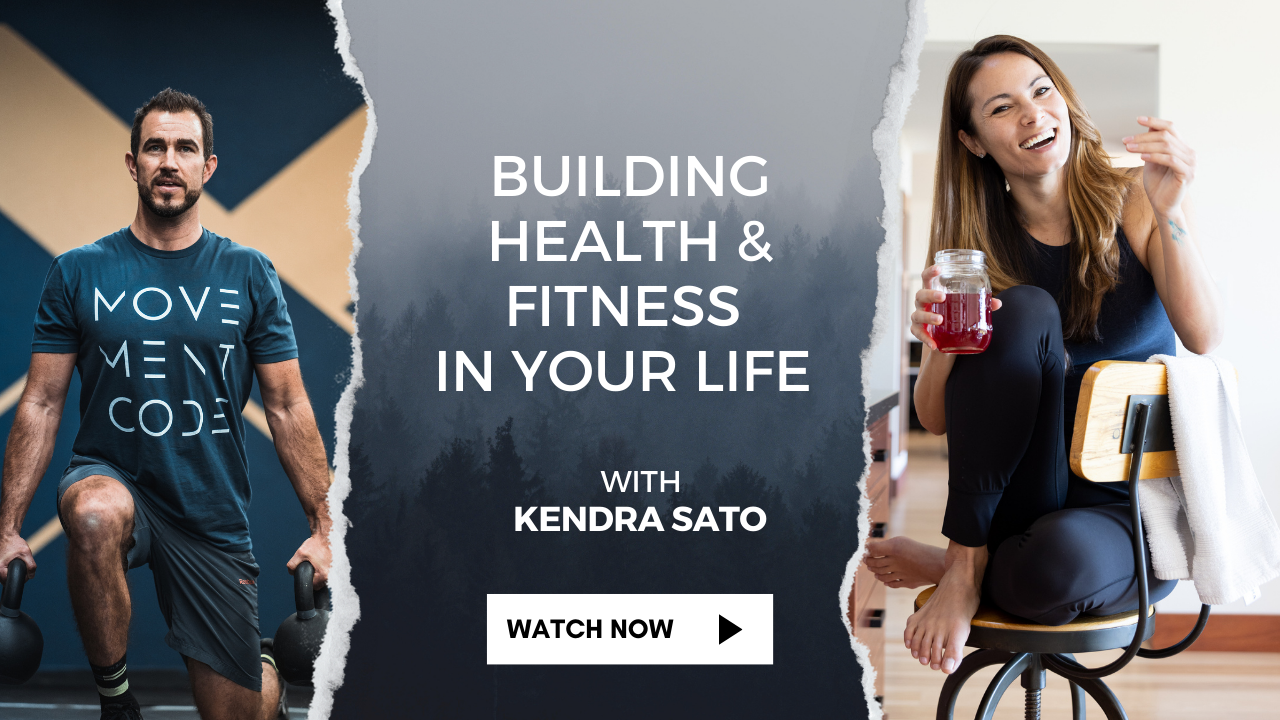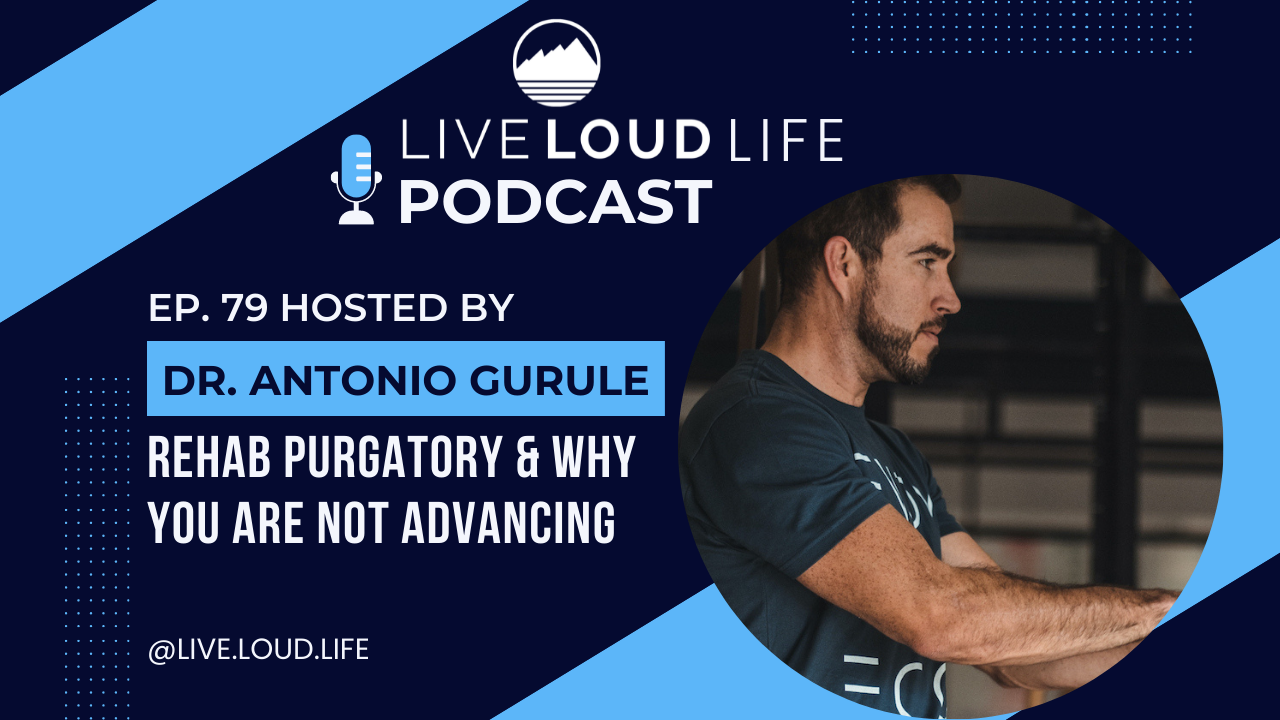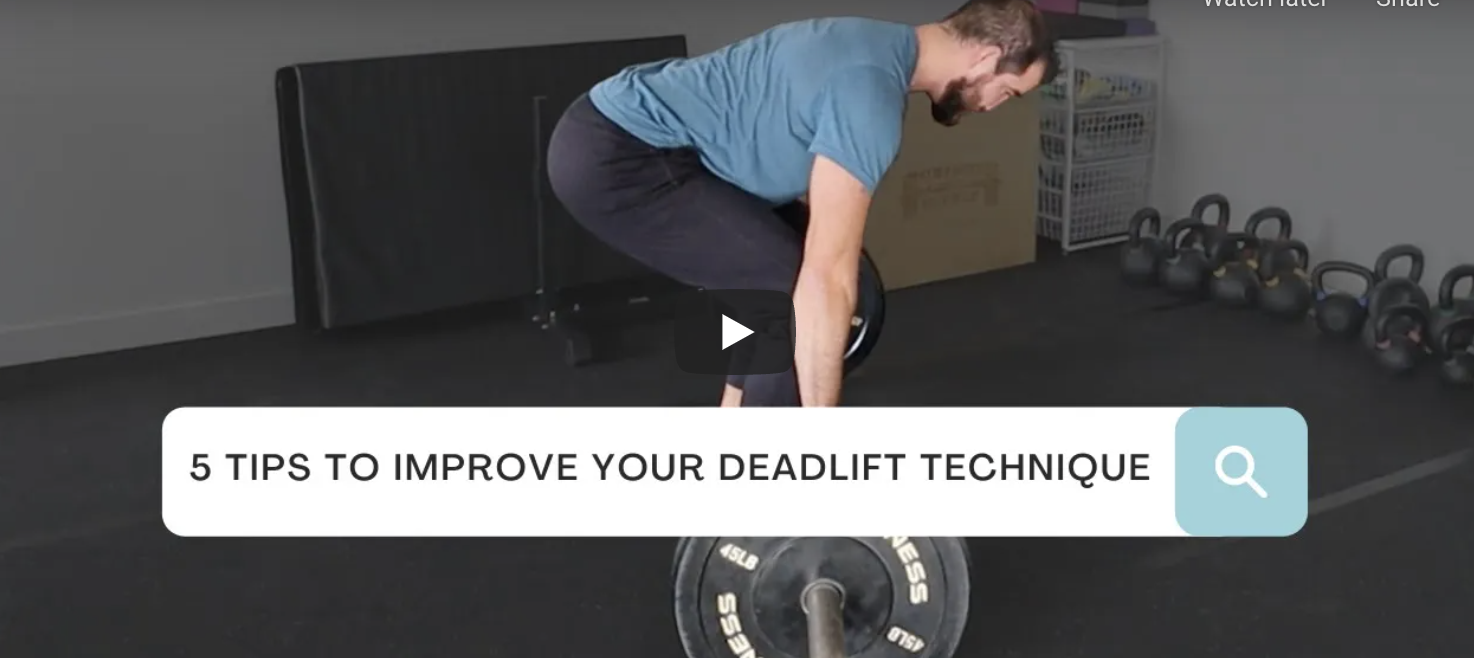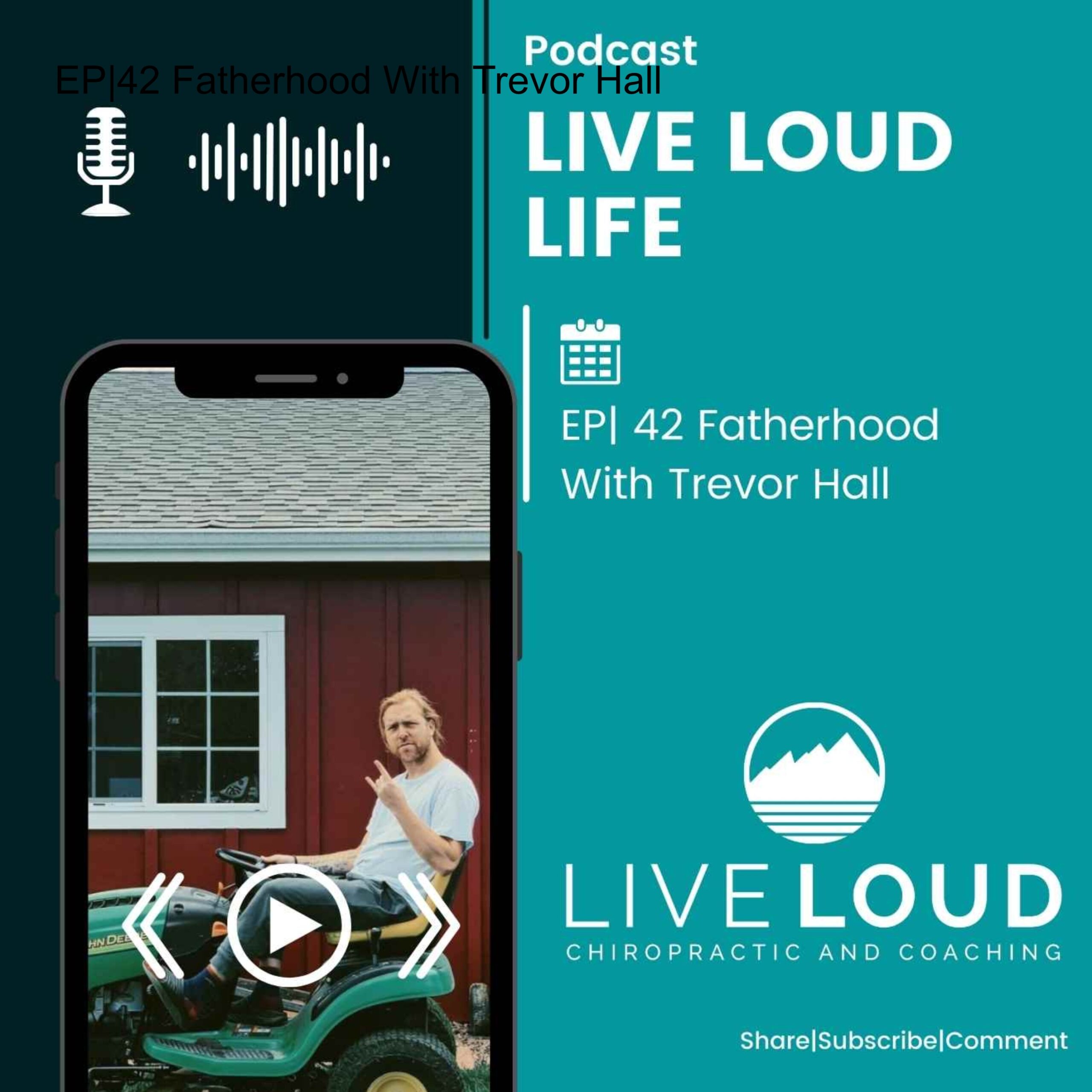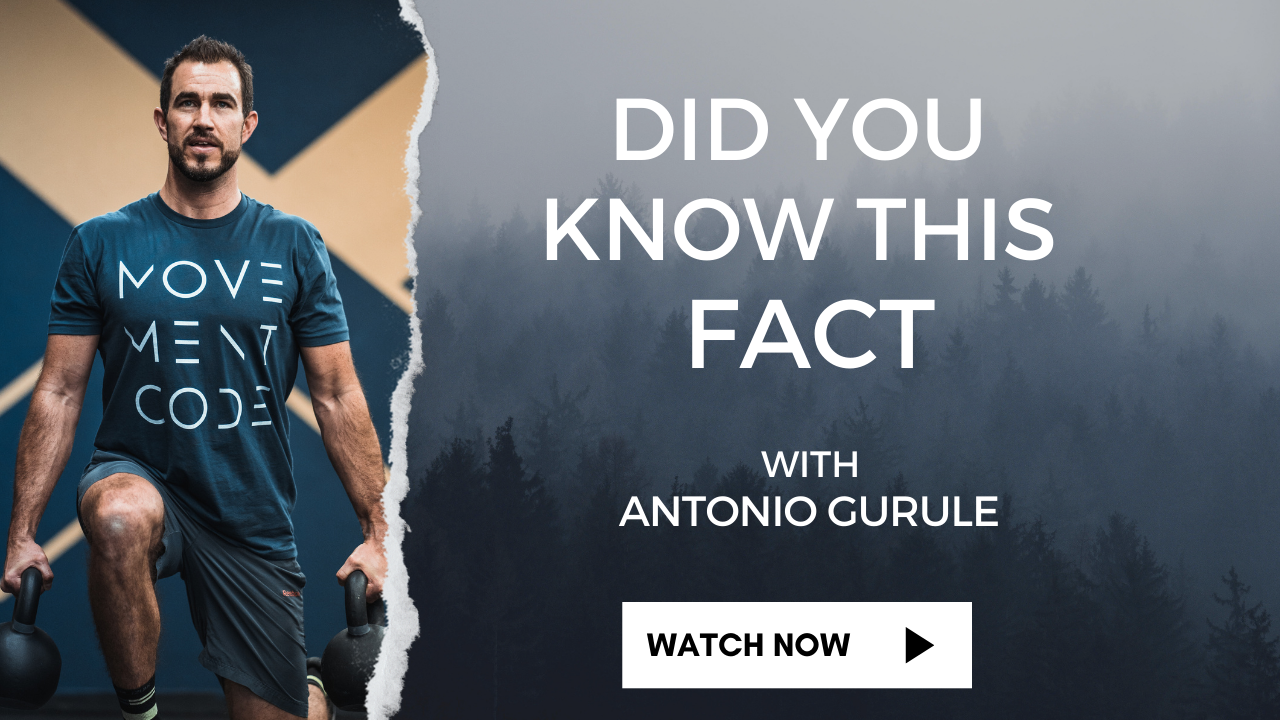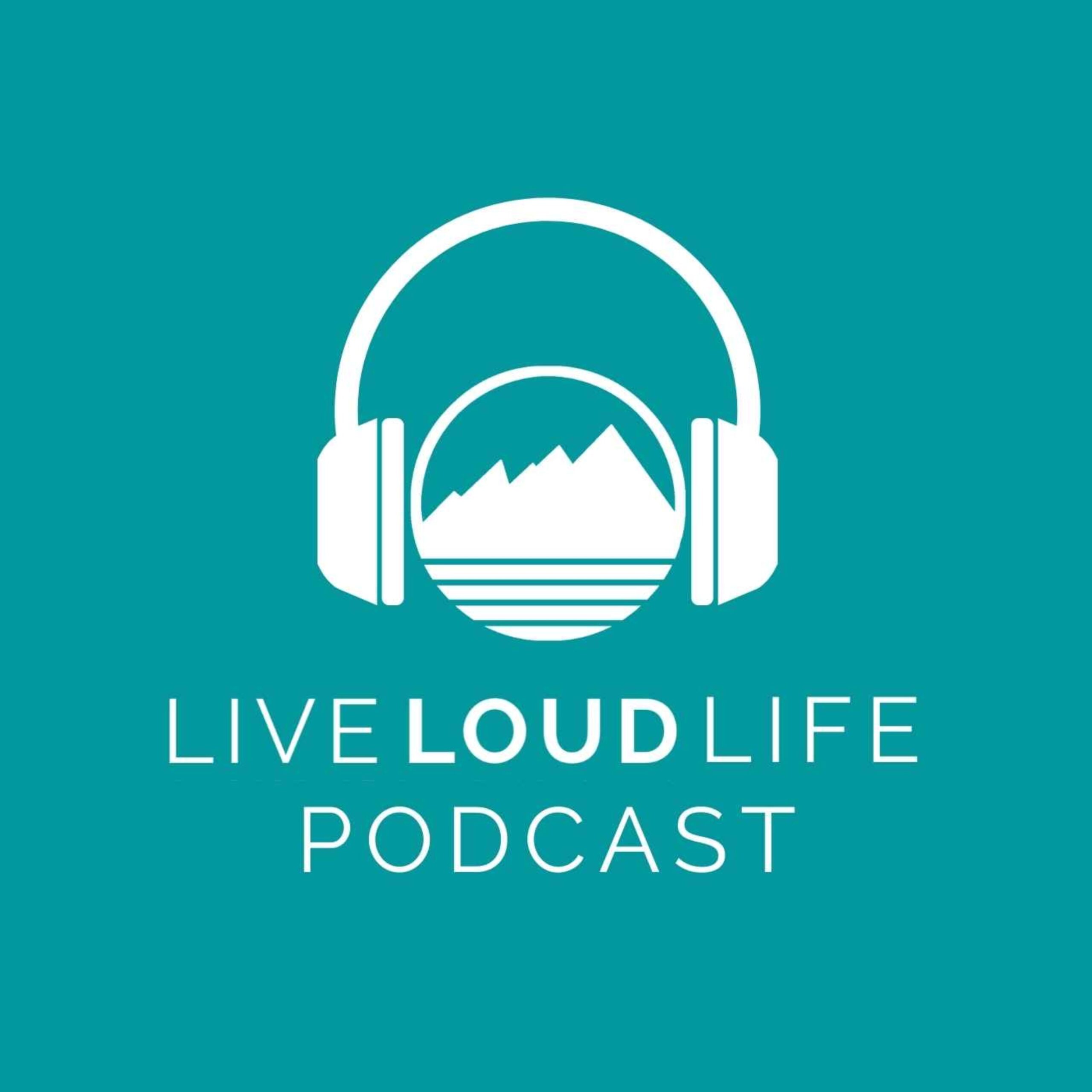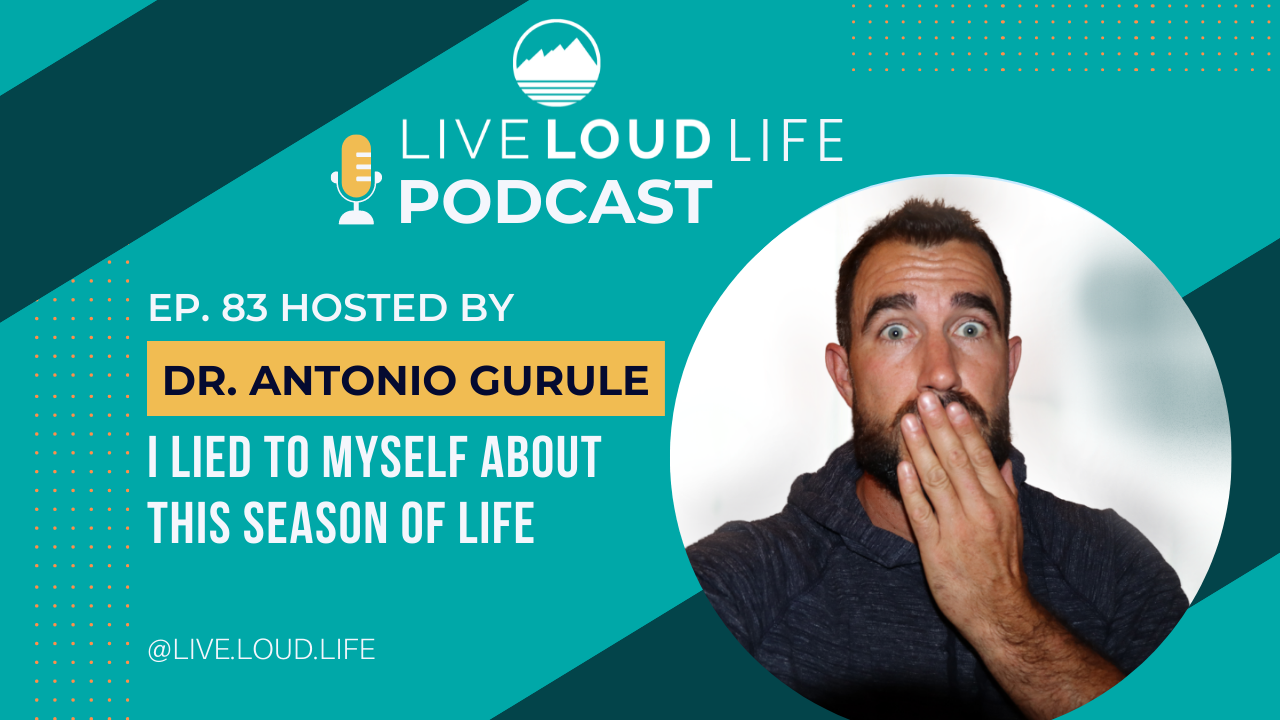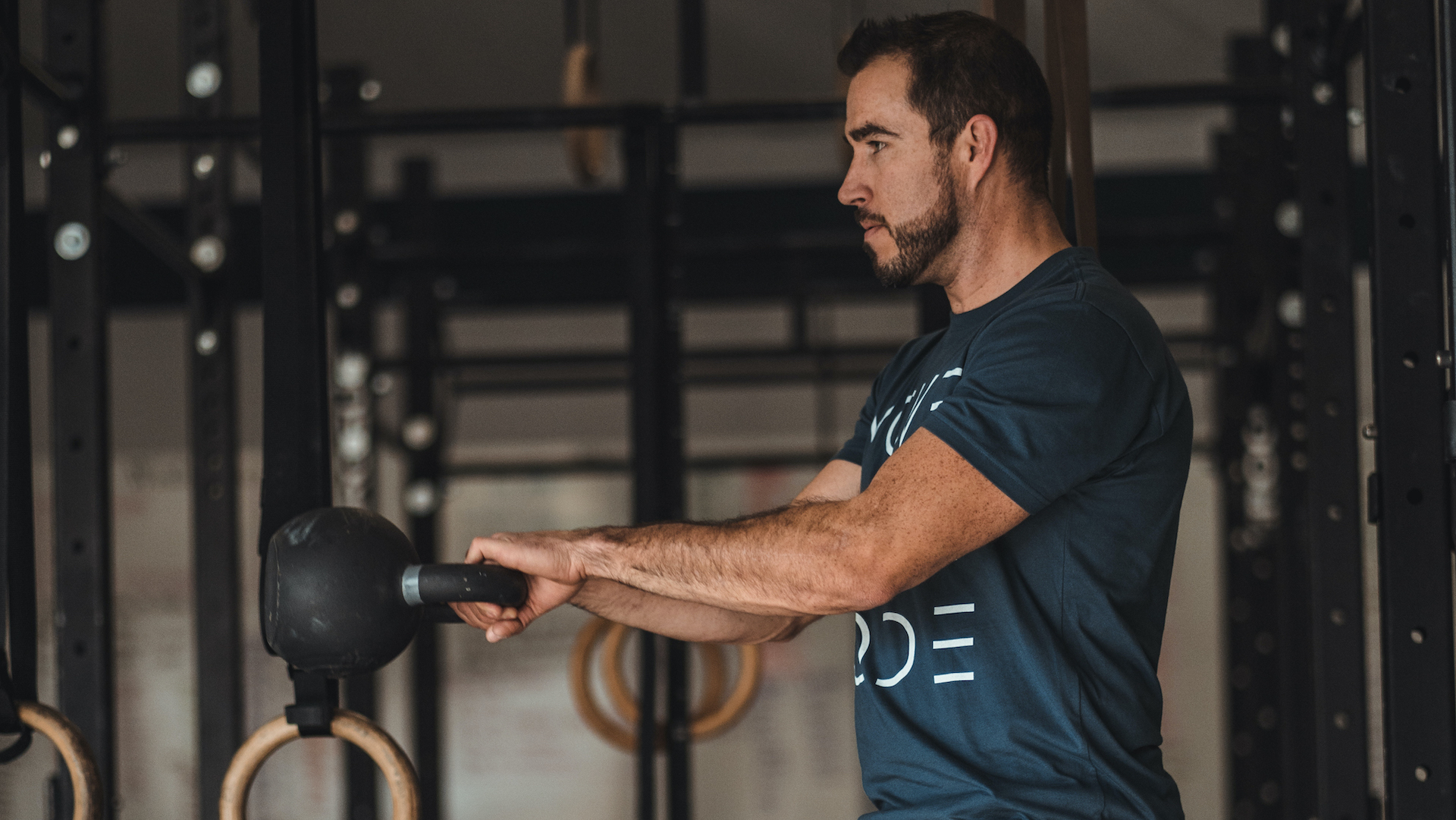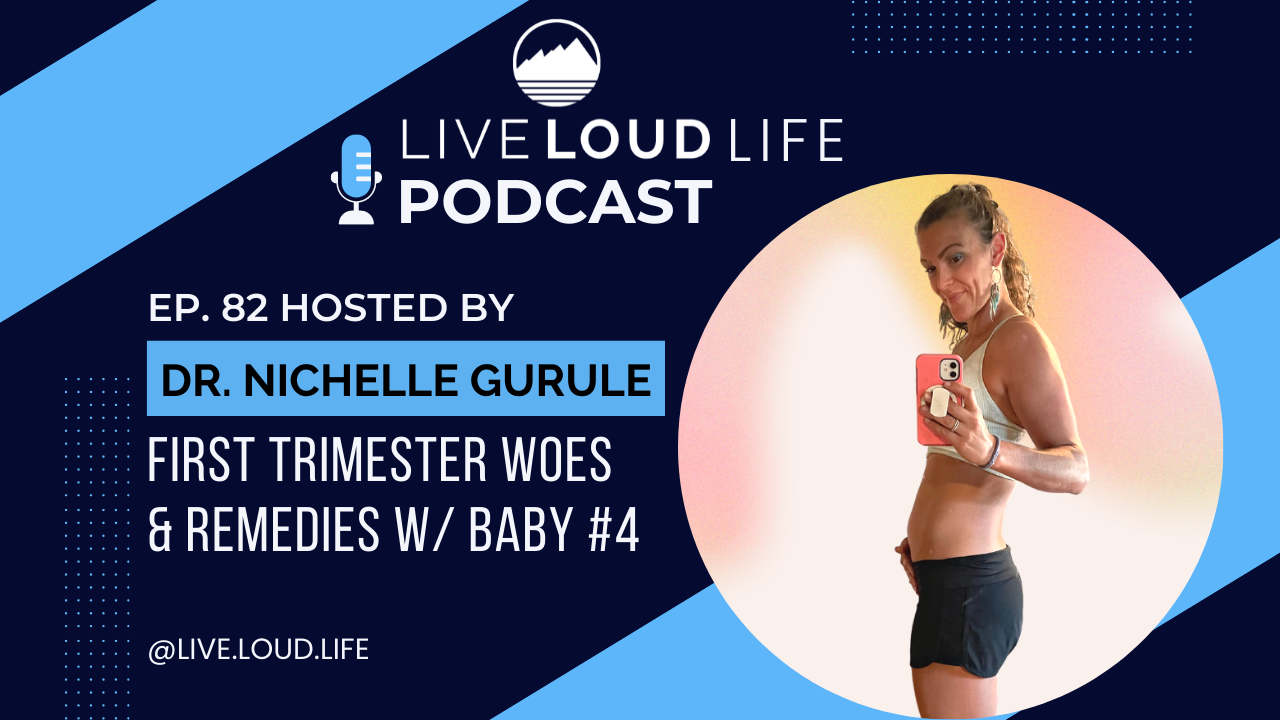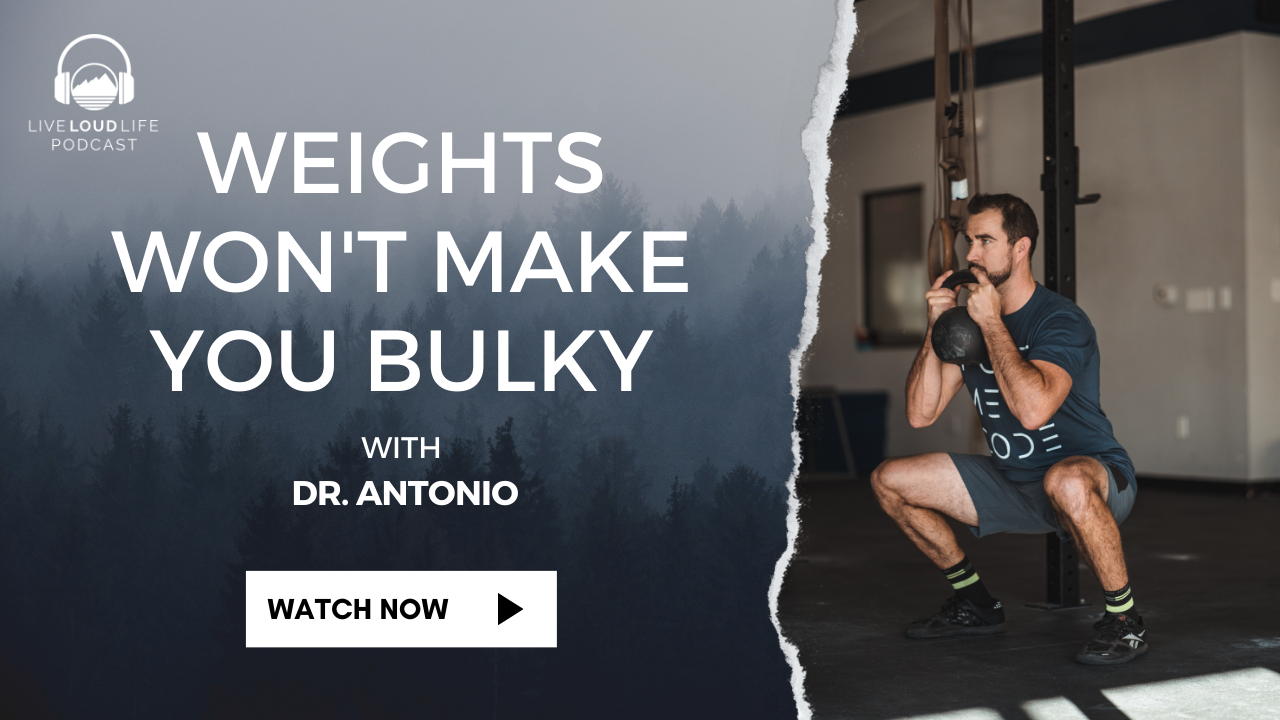Health & Wellness
Sports Care
Sports Care
Staying Healthy as a Weekend Warrior
Millions of people participate in sports each weekend as a way to stay active and stay connected to their friends. Inevitably as we age, the likelihood of an unexpected injury creeps up; so how can you stay healthy as a weekend warrior? You may be surprised to learn that the proactive steps you take during the week to stay well will directly impact your ability to keep enjoying your weekend sports.
Why it Matters:
Weekend sports such as a softball game may last a few hours. If you enjoy hiking or mountain biking, you may be looking at 4-6 hours of sports activities each weekend. Either way, it’s a short amount of time compared to the number of hours you spend working each week. That is why taking daily, proactive steps with your health are so important. Stretching to improve your mobility, strengthening to improve your support, and moving through your entire range of motion can help you feel more energized each day
and potentially reduce your risk of injury on the weekends.
– Weekend warriors have a 40% lower risk of death due to cardiovascular disease
– At least 75 minutes of vigorous exercise is recommended each week
– Regular exercise during the week may help reduce your risk of injury on the weekends
Building a new health habit takes time. Using your smartwatch or a health app is a great way to receive reminders to get up and stretch and move your body. The small steps you take to maintain a balance of strength and flexibility will help you continue to enjoy your weekends. Getting older doesn’t mean you need to stop playing sports, but it does mean that you should be smart about your approach.
Why Pro Athletes Choose Chiropractic
For over 100 years, professional athletes of all kinds have used chiropractic care to recover, reduce their likelihood of injury, and even get an edge in performance. But what used to be a secret is now well-known, and chiropractic care is used by sports teams from high school right up through the pros. Historically, the medical staff of pro sports teams have been focused on helping athletes recover from injuries rather than finding ways to improve their performance (that was left to the coaches). Chiropractors provide a unique bridge between the player, coach, and medical team by focusing on injury prevention, mobility,
and performance.
Why it Matters:
Pro sports are big businesses, and athletes, coaches, and owners always maximize their talent. What began as a way to reduce injuries has advanced into a way to improve performance. New research shows how spinal adjustments can influence the brain, spinal cord, and even muscle strength. Here are three exciting findings from the research.
-
Motor control and movement patterns can be influenced by receiving a spinal adjustment
-
Spinal adjustments can alter how you process pain
-
Increases in muscle strength have been found after a spinal adjustment
Pro athletes choose chiropractic for many different reasons. For some, it’s the focus on mobility, while others are looking for a performance edge. No matter what drives an athlete to seek out a chiropractor’s expertise, one thing is for sure- the use of chiropractic care in competitive athletics is here to stay.
Can an Adjustment Help My Athletic Performance?
You may have heard that chiropractic care can help improve your athletic performance. Is it true? The truth is that many athletes work with chiropractors to improve their performance. Chiropractors unique outlook on health and well-being is a perfect match for athletes and people looking to stay active. To perform at your highest level, you need to optimize your body’s structure and function.
Why it Matters:
Sports keep getting more competitive. Even a slight edge can make the difference between success and failure. Athletes of all ages are always looking for a natural advantage that can help improve their performance. Exciting new research has shown that spinal adjustments can influence muscle strength, balance, and endurance.
Here are the three key takeaways:
-
Pain can reduce your strength, balance, and endurance
-
Spinal adjustments can improve joint and tissue motion
-
Chiropractic patients have been found to have improved strength and endurance
Proactively working with a chiropractor, whether you are in pain or not, is a smart idea for athletes of all ability levels. Assessing your movement patterns, making adjustments when necessary, and helping you craft an at-home exercise plan are just a few of the ways chiropractors help athletes improve their performance.
How to Reduce Your Risk of Sports Injuries
As an athlete, there is nothing worse than being sidelined with an injury. Many athletes report that recovery’s mental aspects are just as hard, if not harder, than the physical recovery. With the proper plan of action, many sports injuries can be prevented. Improper training, incorrect stretching routines, and a lack of a good warm-up can lead to an increased likelihood of sprains, strains, and muscle injuries.
Why it Matters:
Developing a fitness plan that includes dynamic stretching, strength training, and cardiovascular exercise can help decrease your chance of injury. Each aspect of your plan requires movement or biomechanics. Biomechanics is the science of how your muscles, bones, tendons, and ligaments work together to produce movement. Ensuring that you have optimal biomechanics is critical if you hope to reduce your chance of injury. Altered biomechanics in one body joint can lead to compensations in others resulting in pain, increased risk of injury, or potentially advanced degeneration.
-
Take time to move through your bodies full range of motion each day
-
Alternative training different muscles groups every other day
-
Schedule periodic movement assessments to improve your biomechanics
Movement assessments are an essential part of every chiropractic evaluation. Chiropractors are trained to carefully examine your biomechanics and provide both passive and active ways to improve them. No two people move the same, which is why having a qualified healthcare professional analyze your movement is so important. By identifying altered biomechanics before you have pain and discomfort, you may not only be able to reduce your risk of injury but maybe even improve your performance.
Science Source:
The Underappreciated Health Benefits of Being a Weekend Warrior. Harvard Health Publishing. 2017 Impact of Spinal Manipulation on Cortical Drive to Upper and Lower Limb Muscles. Brain Sciences. 2017
The effects of chiropractic spinal manipulation on central processing of tonic pain – a pilot study using standardized low-resolution brain electromagnetic tomography (sLORETA). Scientific Reports 2019
Neurophysiological effects of spinal manipulation. Spine Journal 2002
Effects of Chiropractic Care on Strength, Balance, and Endurance in Active-Duty U.S. Military Personnel with Low Back Pain: A Randomized Controlled Trial. Journal of Alternative and Complementary Medicine 2020
Preventing Sports Injuries. University of Rochester Medical Center
Interested in Something Else?
Extremities
Extremities
Shoulder Pain: How to Find Relief
Your shoulder is the most unstable and moveable joint in your body. Its wide range of motion occurs due to four primary muscles and their tendons, which together are called the rotator cuff. If your shoulder becomes inflamed or an impingement happens, you may make the mistake of trying to avoid using your arm to help it heal. It may surprise you to learn that not moving can actually contribute to more pain or even lead to a frozen shoulder. Controlled movement is one of the best ways to heal.
Why it Matters:
The most common source of pain in the shoulder is the tendons. Your tendons attach the muscles of the shoulder to the bones. If a tendon becomes trapped, it can result in shoulder impingement. If a tendon becomes inflamed, you may hear it referred to as tendinitis or bursitis. And if a tendon becomes torn, you guessed it; you have a rotator cuff tear.
-
Shoulder Bursitis: If the sac of fluid that cushions your shoulder becomes swollen and painful due to repetitive motions, you may have bursitis.
-
Shoulder Impingement: If your tendons get pinched between or under the bones of your shoulder, it can lead to impingement. Lifting overhead repetitively can cause impingement, and it can result in swelling and pain.
-
Rotator Cuff Tear: Your rotator cuff can become damaged due to overuse, injury, or age. Tears usually cause pain when you try to lift things, and you may hear a popping sound as you move.
Your shoulder and spine work together. While it may seem like they are two completely different areas, it’s been discovered that postural abnormalities can play a significant role in your likelihood of developing shoulder pain. Maintaining a full range of motion in your shoulder and spinal joints of your neck and mid-back can help reduce your chances of dealing with shoulder pain. If you notice shoulder discomfort or restricted movement, contact us for a complete evaluation. We’ll work to create a movement-based plan to help you find long-term relief.
Your Hip vs. SI Joint: What’s the Difference?
It can be extremely confusing to figure out the difference between hip and SI (sacroiliac) joint pain. But being able to identify which one is the culprit is crucial when you are looking to find relief. Your SI joint is the connection between your tailbone (sacrum) and your pelvis. The SI joint is very fibrous and only moves a few millimeters. On the other hand, your hip is much less stable and allows your entire leg to move in every plane of motion.
Why it Matters:
While the hip and SI joints are very different in structure and function, they share similar pain patterns, making it difficult to tell one from the other. It’s common to have SI joint pain mimic low back pain. Bending backward usually aggravates SI joint pain due to the compression that happens in the joint as you move. Hip pain is more likely to occur when you walk or if you try to bring your knees to your chest.
-
Hip Pain: characterized by pain with walking, weight-bearing, and rotating the leg
-
SI Joint Pain: characterized by difficulties while standing, walking, climbing stairs, getting out of the car.
-
Low Back Pain: characterized by pain that radiates into the buttock or leg and may travel down to the foot
Suppose you’ve felt discomfort and aren’t exactly sure if it’s your hip, SI joint, or low back- it’s important to find a chiropractor who will provide a complete evaluation and treatment plan. The reason this is important is that our hips tend to become degenerative as we age, and if your doctor is only looking at a hip X-ray to determine a plan of care- you may find yourself getting treatment for a problem you don’t have. We take a holistic approach to our evaluations, and our movement assessments ensure that we can pinpoint your challenges so that you get the best care plan to live your highest quality of life.
Are You At Risk for Chronic Knee Pain?
Knees hurt? You’re not alone. Chronic knee pain is thought to affect up to 25% of adults and can significantly limit your mobility and quality of life. Your knee is a hinge-joint that primarily moves back and forth (flexion and extension) and allows some twisting or rotation. Every step you take places stress and strain on your knees, so it’s no surprise that trauma, misalignment, and degenerative changes can all take their toll.
Why it Matters:
While knee pain may not be entirely preventable, there are steps you can take to keep your knees as healthy as possible. At the top of the list is to watch your weight. For every pound you are overweight, your knee must absorb an extra 4 pounds of pressure when you walk, run or climb stairs. In addition, the cartilage in your knee is designed to last a lifetime if you take care of it. Here are a few additional ways to keep your knees healthy and strong.
Warm-Up Before Exercising: Stretching your quadriceps and hamstrings before and after you exercise is a smart way to reduce the chance of a flare-up of knee pain
Find Adequate Foot Support: Every step you take transfers force from the bottom of your foot to your knee. Therefore, your shoes should provide the support you need to keep your knees healthy for at least 10,000 steps per day.
Maintain a Full Range of Motion: Ensuring your low back and hips are moving freely is essential to overall knee health.
The joints of your body should have a balance of strength and flexibility through their full range of motion. Unfortunately, it’s not uncommon for people with back issues to find themselves struggling with knee pain after limping around for a few weeks. We encourage our patients to be proactive with their health. Use the strategies above to help reduce your chances of knee pain, and be sure to call our practice if you notice any pain or restricted motion.
Tennis Elbow? But I don’t even play tennis!
Tennis elbow isn’t just for athletes. Lateral epicondylitis (tennis elbow) is a painful condition that occurs when the tendons in your elbow are inflamed and overloaded due to repetitive motion. Because of the motion that occurs when swinging a racket, it’s commonly referred to as tennis elbow, but anyone who has a job that features repetitive arm motions may be at risk.
Why it Matters:
Tennis elbow can become a serious issue because of the pain and weakness that make it difficult to perform your daily tasks. Because it’s an injury caused by repetitive motions, and since many of these motions are essential to your job, finding ways to decrease the inflammation and improve biomechanics is critical. Three natural ways to help reduce the pain associated with tennis elbow include:
-
Rest: Giving your arm time to rest is important to stop the cascade of inflammation and pain Ice: Icing, a few times per hour, is a smart strategy to reduce pain and inflammation
-
Technique: Be mindful of how you are moving your arm, use proper ergonomics, and use a brace for a short time if necessary
Tennis elbow is usually not a condition that will go away on its own. However, we’ve found two key strategies for reducing the pain associated with tennis below. First is receiving a plan of care that includes at-home exercises to strengthen your supporting muscles. The second is receiving adjustments, when necessary, to improve the motion and movement of your elbow joints. If you or someone you know has struggled with tennis elbow, give us a call so that we can provide you with a plan to find relief.
Science Source:
Immediate Effects of Spinal Manipulation on Shoulder Motion Range and Pain in Individuals With Shoulder Pain: A Randomized Trial. J Chiropr Med 2019
Sacroiliac Joint Dysfunction. Spine-Health 2021
Chronic Knee Pain. Healthline. 2021
Tennis Elbow. Orthoinfo by the American Academy of Orthopedic Surgeons. 2021
Want to Keep Reading?
Healthy Habits and Resolutions
Healthy Habits and Resolutions
Healthy Habits and Resolutions
Setting Smart Health Goals
Have you ever felt like you were working hard but weren’t making any progress toward your goals? You’re not alone. Most people feel that way each year around their time. They set goals, take a few action steps but never seem to accomplish very much. Often the problem isn’t a lack of motivation- it’s just that you haven’t set smart goals. Smart health goals can help you clarify your thoughts, focus your efforts, use your time to your advantage, and increase your chances of not only achieving, but surpassing your expectations.
Why it Matters:
Living a healthy life requires more than just being free from pain. Setting health goals, stretching your comfort zone, and celebrating small wins are important parts of a fulfilling life. As you plan your New Year’s resolutions for a healthy year, plan smart goals. Smart health goals are an effective way to provide the clarity, focus, and motivation you need for success. By setting a completion date, you are more likely to reach your goals.
S – Specific- make your goals specific for more effective planning
M- Measurable- define how you are making progress
A- Attainable- make them reasonable to accomplish
R- Relevant- your goals should align with your values
T- Time-Based- set a date of completion
If you struggle to follow through on your New Year’s resolutions each year, try setting health smart goals. There is no better time than right now to begin setting goals to improve your health this year. Living a healthy life is a journey, so don’t forget to celebrate each step of your progress. Our practice is here to help guide you along the way. If you have a health challenge or an ache or pain that’s holding you back from reaching your goals- let us know- we’ll be happy to help!
How to Cultivate a Positive Mindset
Mindset is the #1 predictor of success. Often, the conversations that you have with yourself determine your growth (or lack thereof). Whether you believe you can or can’t do something, you’re probably right. Thinking that you can’t do something can become a self-fulfilling prophecy that prevents you from taking action and making the decisions you need to live your best life.
Why it Matters:
The good news is you can change your habits, beliefs and transform your thinking. When you do, you’ll be able to look at the world with a new perspective, which empowers you to become the person you know you can be. Take some time this week to think about the thought loops that play in your head. Be more conscientious about what you tell yourself. Each day, identify what thoughts you can switch to cultivate
a more positive mindset.
Positive thinking can help with managing stress and improve your health
A positive outlook can decrease your likelihood of a heart attack or cardiovascular event by over 30%
Negative emotions may weaken your immune response
Cultivating a positive mindset isn’t just a woo-woo, granola way to approach life. A positive mindset has been shown to improve your overall health and well-being. New research on the mind-body connection has proven that our mental health impacts much of our physical health.
Moving Your Way to Better Health
You’ve heard it before, but regular exercise is good for your physical and mental health. Daily exercise can help you lose weight, lower your risk of future health challenges, reduce your stress, and improve your mental outlook. But, if you’re like many people, over 80% to be exact- you aren’t getting enough exercise each week.
Why it Matters:
As a chiropractor, we focus on three types of movement- segmental (your body’s individual joints), regional (your neck, low back, leg, etc.), and whole body. All three types of movement are essential for you to stay well. Full body movement is general exercise such as running or walking. Regional movement may be the stretches and smaller exercises you perform daily. Segmental motion is what we focus on here as chiropractors. To generate the benefits of regular exercise, your body needs all three types of movement.
Whole Body: daily exercise can improve your mood, sleep and lower your risk of chronic disease
Regional: dynamic stretching can improve your range of motion, biomechanics, and energy levels
Segmental: adjustments can positively influence the function of your nervous system, decrease aches and pains, and relax your muscles
Millions of people make New Year’s resolutions to get more active each year. And each year, they seem to come up short. But this year, you have the tools and resources to succeed. By setting smart health goals and cultivating a positive mindset, you can begin moving your body towards better health this year. If you notice yourself struggling to stay on track, or sidelined by chronic aches and pains, let us know. We’re here to help you get active, stay healthy, and reach your goals.
Increasing Your Energy
Have you found yourself tired and drained at the end of each day? It may be easy to grab a second (or tenth) coffee or energy drink, but boosting your energy level doesn’t mean you need to rely on caffeine’s short term effects. Short term bursts of energy can often lead to a crash. Creating smart, healthy habits each day can increase your energy level, mental focus, and endurance.
Why it Matters:
Walking through a store, you’ll notice dozens of products that are designed to increase your energy level. Many of these synthetic stimulants aren’t very healthy, and some can even become addictive. Instead of a daily quick fix, it’s better to consider the effect that stress, exercise, and diet can have on your energy levels.
Stress: being stressed out consumed a ton of energy. Discovering ways to decrease your mental stress with meditation or physical stress with chiropractic care can help increase your energy levels
Exercise- daily exercise will help you sleep better, elevate your mood, and circulate more oxygen in your body
Diet: eating foods with a low glycemic index (where sugar is absorbed slowly) can help you avoid a crash after eating and keep you more energized throughout the day
A lack of energy is often a symptom of a more significant issue. Too much stress, less than ideal food choices, and a lack of exercise are major factors on your energy level. Developing an awareness of your daily habits and making small changes can result in big changes. Try to avoid using caffeine as a crutch and make positive lifestyle choices instead. If you’re struggling or would like specific natural supplement recommendations, let us know, and we’ll be glad to help.
Science Source:
MindTools. Smart Goals: how to make your goals achievable.
Mayo Clinic. Positive thinking: Stop negative self-talk to reduce stress. 2020
Johns Hopkins Medicine. The Power of Positive Thinking
Cleveland Clinic. 80% of American Don’t Get Enough Exercise. 2018
The use of spinal manipulation to treat an acute on field athletic injury. The Journal of the Canadian Chiropractic Association. 2016
Harvard Health Publishing. 9 tips to boost your energy — naturally
Spinal Discs
Spinal Discs
What are Spinal Discs Made Of?
We all know spinal discs are important- but to understand why, the real question is; what are they made of? Your spinal discs are little cushions that sit between the bones or vertebrae in your spine. Each one of your discs is made up of a tough, fibrous outer layer (annulus fibrosis) and a jelly-like inside layer (the nucleus pulposus). The tough outer layer contains and protects the softer inside layer. These small discs have a big job. They enable your spine to move in all directions.
Why it Matters:
The nucleus pulposus (inner layer of the disc) is mostly made up of water. The high water content helps your discs stay supple and moveable. It acts like a small swivel to allow your body to tilt and rotate. As you get older, your discs tend to lose their high water content and can become degenerative. Degenerative discs don't move as well, are more prone to cause pain, and even contribute to compression on your spinal nerves.
-
Your spinal column has 24 moveable bones with spinal discs between each pair
-
Spinal discs are designed to help your move in all directions
-
Movement of your spine can help keep your spinal discs healthy
Movement is one of the best ways to keep your spinal discs healthy. Since your spinal discs don't have a very good blood supply, movement is how they bring in nutrients. Moving your spine helps your spinal discs get in nutrients to stay healthy and push out waste contributing to pain and inflammation. If your neck or back hurts, give us a call- we'll help you get your life back from pain.
What Causes Inflammation?
What Causes Inflammation?
Chronic inflammation is one of the most significant health issues many of us will face today. It’s been linked to everything from chronic pain to a wide range of other mild and serious medical conditions.
It’s important not to mistake acute inflammation for chronic inflammation.
Acute inflammation describes your body’s natural defense mechanism against injuries or toxins. When your immune system is constantly stressed, it can then lead to chronic inflammation which in turn can lead to other conditions.
Why it Matters:
In 2014, it was estimated that over 50% of people had at least one chronic condition, and 40% had more than one.
Chronic inflammatory diseases can include respiratory and heart disorders as well as diabetes.
The majority of these disorders are linked directly to our lifestyle choices. Each day you have the option to either increase or decrease your state of inflammation.
Here are some fundamental ways to start taking your life back from chronic inflammation:
-
Eat right. Fruits and vegetables are high in natural antioxidants and may protect the body against inflammation.
-
Get enough rest. Maintaining a regular sleep schedule can reduce your physical and emotional stress levels, which has been linked to a lower risk of chronic inflammation.
-
Stay active. Exercise can lower the amount of pro-inflammatory chemicals in your body and benefit your cardiovascular and mental health.
Reducing your risk of chronic disease and inflammation begins with the choices you make each and every day, and we’re here to help you make the best decisions to help you live a full, active, and healthy life.
If you believe you’re not eating, sleeping, or moving as well as you would like, be sure you have an appointment scheduled with us. Together, we’ll analyze your habits and create a plan to get you and your well-being back on track.
Most Chronic Diseases are Linked to Inflammation
One of the most important health discoveries of the past 20 years has been that the immune system and inflammatory process are involved in nearly every mental and physical health problem we encounter today.
It’s safe to say that chronic inflammation is a leading cause of chronic disease.
Why it Matters:
Chronic inflammation is a condition that can affect your immune system and can influence all of your organs, tissues, and cells.
Unlike the normal inflammatory response that happens after an injury and goes away within a few days, chronic inflammation is an abnormal response that can last years.
Here are just a few of the ways chronic inflammation can affect your body.
-
Chronic inflammation can cause your immune system to function sub-optimally.
-
Fatigue, increased blood pressure, insulin resistance, and poor appetite have also been linked to chronic inflammation.
-
Heart disease and other neurodegenerative disorders have been linked to long-term chronic inflammation.
It’s true. It’s impossible to prevent chronic disease completely, but you have the power to reduce your risk every day.
Taking action steps like eating right and exercising each day have been shown to dramatically decrease chronic inflammation and your likelihood of developing a chronic disease.
Know we’re here to help you live an active and fulfilling life. We understand that it’s hard to get enough exercise each day when you’re in pain. We hope you’ll take a moment to schedule a movement assessment with us so we can create a plan to help you start moving and feeling better..
Let’s take the first step towards reducing your risk of chronic disease together!
How Inflammation Affects Your Body
Inflammation is like a check engine light for your body. It tells you that something isn’t quite right, and you should pay attention.
The first step in discovering the cause of the problem is determining whether you have acute or chronic inflammation.
Acute inflammation is short-term and plays a critical role in healing and injury repair. Chronic inflammation on the other hand describes a condition where your immune system continues to produce white blood cells and chemicals even after the injury is gone.
Why it Matters:
The combination of chronic inflammation and an excess of white blood cells can cause some problems for your immune system. In some cases, your immune system may even begin to target healthy cells and structures.
If sustained over a long period of time, you may experience changes in your cells, tissues, and organs that can increase the likelihood of disease.
Of course, one of the most significant challenges is that chronic inflammation can be invisible unless you know where to look.
Here are a few of the most common signs of chronic inflammation.
-
Insulin resistance. Insulin helps control the sugar level in your blood, and inflammation could affect how well your insulin works.
-
Muscle weakness. Chronic inflammation can cause your immune system to mistakenly attack and inflame your muscles, which could make you weaker.
-
Fatigue. Fatigue is a sign of long-term inflammation and common in inflammatory diseases like fibromyalgia, multiple sclerosis, lupus, and rheumatoid arthritis
If you’ve been living with muscle weakness, fatigue, or other nagging pains, you may also be living with chronic inflammation.
It’s often your daily habits that contribute to this state of chronic inflammation.
Know that our team specializes in helping you create a healthy lifestyle through daily habits that combat chronic inflammation.
We invite you to take the first step towards better health by scheduling your next visit with us today so we can work together to help you feel and function at your best.
How to Reduce Pain and Inflammation Naturally
While the inflammatory process is extremely complex, the solutions aren’t. Reducing pain and inflammation naturally is simple with the right strategy.
Maintaining a healthy weight, eating a balanced diet, getting enough sleep, and exercising regularly are all ways that have been shown to effectively reduce pain and inflammation naturally.
Why it Matters:
Your diet and daily exercise routine play a huge role in managing chronic inflammation because each influences your weight and sleep patterns.
Foods high in antioxidants (like berries, turmeric, green vegetables) can lower your overall inflammation and provide you with more energy. Daily exercise can help protect you against conditions such as heart disease and obesity, which have both been linked to chronic inflammation.
Did you know…
-
Antioxidants known as polyphenols can lower inflammation.
-
Even 20 minutes of daily exercise can have an anti-inflammatory effect.
-
Proper sleep patterns encourage recovery and can lower stress and inflammation levels.
Reducing pain and inflammation naturally starts with your ability to move your body and exercise daily.
If you notice an injury or pain is slowing you down, take a moment to schedule an appointment with us today.
Our expert team will work with you side by side to help you move better, and once you start moving better, everything else becomes easier!
Give us a call. Let’s make chronic inflammation a thing of the past.
Science Source(s):
Chronic Inflammation in the Etiology of Disease Across the Life Span. Nature Med. 2019.
Chronic Inflammation. StatPearls. 2021.
Signs of Chronic Inflammation You May Not Expect. WebMD. 2019.
Understanding Acute and Chronic Inflammation.
Harvard Health Publishing. 2020. Understanding Acute and Chronic Inflammation. Harvard Health Publishing. 2020.
3 Things I Would Never say to Someone with Low Back Pain | EP 88
Live LOUD Life Podcast
Lafayette Colorado
Episode 88
EP|88 3 Things I Would Never say to Someone with Low Back Pain
With Dr. Antonio Gurule
HIGHLIGHTS:
[0:09]What I would never say to a patient.
[2:03] What to do when you have lower back pain?
[4:13] What adjustment and manipulation can do for you.
[6:07] The importance of proper assessment and evaluation.
[7:55] More than alignment, we need function.
[9:38] Have a good assessment and evaluation with your provider.
Connect With Antonio and the Live LOUD team: hello@liveloudlife.com
Subscribe to my YouTube channel here: https://www.youtube.com/c/LiveLoud
Visit the website: https://www.lifeloudlife.com
Like the Facebook page: https://www.facebook.com/liveloudchiropractic/
Follow on Instagram: https://www.instagram.com/live.loud.life/
Guiding you to the adventurous life you were made for!
.
If you dig this give it a like ❤️, if you’re loving it let me hear you with a comment 🗣👂, and if you know it will help someone or anyone out please share 👥📲
Live Loud Chiropractic and Coaching Top Chiropractor and Physical Therapy in Lafayette Colorado Serving Boulder County Boulder, Longmont, Louisville, Erie, Broomfield, and Arvada Colorado
About Dr. Antonio Gurule
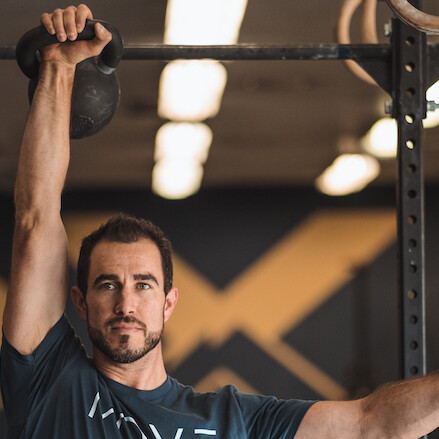
Background:
- Father
- Doctor of Chiropractic
- Owner of Live LOUD
- Personal Trainer & Health Coach
Check Out Some of Our Other Blog Posts and Podcast Episodes
Anthony Gurule 00:00
Hey what’s up guys, welcome back to another episode of the Live LOUD Life podcast. My name is Dr. Antonio, I’m your host of the Live LOUD Life podcast. My wife and I, we co-own Live LOUD Chiropractic and Coaching here in Lafayette, Colorado. We are just outside of Boulder, Colorado in Boulder County. And our mission is to help families. We want to help make families stronger, so that we can build a stronger community. We want to help guide you to the adventurous life that you and your family were meant for. And we do this through chiropractic and coaching. chiropractic, obviously being more of a hands on approach, more of a clinical conversation, clinical diagnostics, but the coaching aspect is really what we believe is, you know, the foundation of what our system methodology, whatever you want to call it is, because a lot of this comes around through just coaching suggestions and recommendations. also, you know, obviously within that comes into clinical prescriptions of certain things to eat or supplements, so on and so forth. But it’s coaching a lifestyle, it’s coaching, it’s coaching a philosophy and a foundation about how to live an active healthy life as an individual, and setting an example of a healthy active life for your family, for your immediate family, for your friends, and more importantly for your community. So stronger families to make a stronger community as a whole would be a win win, right? And that’s what we want to be able to do. we want to be able to help fill in the gaps in the holes that you’re maybe not getting from, from other roles and conditions.
Anthony Gurule 01:43
And today that’s in particular where we’re going to talk about. it’s going to be a little bit more of a shorter episode because this is more of a quote unquote, you know, just discussion around how to lay out a framework and a better understanding of how to work out or what exercises are safe or maybe not safe during pregnancy. This is a very, very common question that we get.
Anthony Gurule 02:12
My wife Nichelle has created a mini course that has some workout ideas, recommendations, and prescriptions than laid out into a workout. She guides and educates other clinicians on how to broach this topic as a chiropractor, how to better serve prenatal patients through chiropractic care, but also exercise recommendations and prescriptions, having recommendations with other personal trainers within the community whether that’s CrossFit whether that’s Orange Theory, chatting with coaches and owners and saying hey, if you have prenatal patients and they’re having these types of symptoms, or this has happened, here’s some better recommendations, not modifications. We call them lateralizations–you’re just you know, you’re doing something something different or something else we you know, we borrow that term from Charlie Weingroff, who’s a physical therapist and strength conditioning coach. But it also and also doulas, right, doulas and midwives and OBs who are directly involved with the prenatal process from nearly conception all the way through, having this conversation. we know that exercise is important during pregnancy,
Anthony Gurule 03:19
There are so many different studies that talk about the benefits of exercising during pregnancy, not only for the mom, but also for baby, which is quite interesting. They’re seeing increased cognitive-what’s the word I’m looking for? Excuse me, their cognitive output as a as an as a child through as they age is actually better from moms that actually worked out during pregnancy.
Anthony Gurule 03:50
Now this is tough, right? How do you define working out or exercise? it’s different for everybody. But we want to, and we encourage that, and yet we’re sympathetic to the different stages of life, aches and pains, so on and so forth, which obviously would limit what you can do from an exercise perspective. So you know, it’s a bit of a gray area on determining what is working out? what is exercise? What are the physical guidelines or recommendations for pregnancy? And without getting into the like, nitty gritty detail of every single thing. And obviously, every potential situation, if you had this versus this, what could happen? we’re not gonna be able to do that. What we just want to lay out is what is what are we trying to accomplish here, and we want to encourage you to stay as physically active as possible.
Anthony Gurule 04:41
And one of the things that constantly comes up is, well, should you add something in that you have not already been doing? Let’s say for instance, someone just through the stages of life with work and kids or whatever that is, they were not able to work out as much before they got pregnant, but now that they’re pregnant, whether they have more time or they understand the importance of exercises during pregnancy, well, would we say, “Well, you haven’t been exercising, so you shouldn’t do too much.” No, that doesn’t, that doesn’t really make sense. Now, we would encourage not to do too much, there’s obviously, you know, a too far swinging the pendulum of the other way. But we wouldn’t say “no, don’t exercise because you weren’t doing something before,” we just have to find those first few stepping stones to help them start to gain some momentum. and help hold their hand, if you will, So that their technique and they feel confident about lifting, or how far they’re walking or whatever that is. And that’s an important topic, because a lot of times people want to add things in, but they weren’t quite ready or weren’t doing them before. And they then assume that they’re not able to do them at all. So you do have to take that in consideration, there is a ton that you can do, and that you can still add, even though you weren’t doing them prior to pregnancy.
Anthony Gurule 05:54
Now on the big questions is, is it safe? you know, outside to contact sports, or different things like that the majority of what you’re going to do is safe for pregnancy, right? Rock climbing, we have pregnant patients that have been rock climbing before, obviously, there’s a certain inherent risk with certain sports or activities. You know, you could fall off riding your bike, you could fall over running, right, so we’re not encouraging any of these by any means. We’re just kind of, you know, setting some suggestions, if you will. And you have to take into consideration.
Anthony Gurule 06:31
Now, there are certain things to consider when you’re talking about like weightlifting, and how heavy and the intensity that you’re doing. And if you’re doing Valsalva movements, which is essentially holding your breath to maintain a more rigid or stiff torso, as you’re seeing changes in blood volume and blood pressure, you know, you do have to take that in consideration. And that is again, of course a conversation with your provider that is managing your, your pregnancy, but we recommend Mama’s weight lift, or do resistance training. During pregnancy, again, we talked about about load management and the intensity and things like that, but you can still lift and do fairly intense things. And it’s a fairly as a you know, as a scale and a wide range during pregnancy and see a ton of benefit from that. Now, are we trying to hit one rep maxes and PRs during pregnancy, I mean, some would argue yes, but I would argue, why, that’s not really an accurate representation of what your strength is anyways. So you know, you do have to to kind of keep manipulating the numbers and the weights and the intensity and the sets and reps in order to do it. But weightlifting and resistance training is safe, and it is effective. Now, outside of that, there’s not a lot of unsafe things to do, again, outside of contact sports, or things that would elicit, you know, potential trauma to you or baby based on impact we’ve had, again, not our recommendations, but some have tried very just easy scheme, because they’re in the winter months, and they wanted to and they felt very confident about not falling. So you know, you have those types of things.
Anthony Gurule 08:16
Overall, again, we’re talking about movement. You need to move, and it’s good to get your heart rate up. And it’s good to breathe hard. So that doesn’t mean just because you’re pregnant, you can’t do HIIT training or circuit training or CrossFit or Orange Theory. But you do have to listen to your body and understand certain signs that would indicate that things might be too much, right? Now those are going to be different for everyone, but a lot of this comes down to you know, lightheadedness, you know, breathing too hard. Certain aches and pains within lower extremity, chest, abdomen, so on and so forth would be obviously like your more extreme ones. If you’re becoming pale or anything like that, I mean, again, these are the same criteria, though, that would be if someone else was working out or training too hard. So it’s realistically the same thing. It’s just that your threshold level for all those most likely have gone down. And depending on what type of an athlete you were before, you’re going to be maybe a little frustrated that you’re not able to do the things you were able to do previously, which makes sense. But if you’re someone who wasn’t exercising before, you’re probably going to be a little bit more hyper aware of that, of just feeling that shortness of breath or that uneasiness. So again, we’re not saying you have to push through that because we’re not trying to set yourself up for a strength and conditioning program to increase your metabolic capacity to increase your strength and conditioning during pregnancy. We’re trying to help you maintain a healthy active pregnancy.
Anthony Gurule 09:54
Now, walking. walking is great. but in general, we encourage you to do something above and beyond walking. Obviously, again, certain things would dictate that you would not be able to do so. And this is again, any exercise. Any exercise that you do during pregnancy needs to be consulted with and work through and have a conversation with the primary physician who is managing your pregnancy, whether that’s your nurse practitioner, your midwife or your OB or obstetrician, right. But we would encourage more than just walking. walking is fantastic, but that’s kind of like your baseline minimum, right? Just like our activities, or recommendation activity guidelines. We want a few days a week of where we’re kind of just doing this steady state getting our steps in, you know, kind of pushing ourselves, we’re huffing and puffing, but still just kind of at that conversational level, but you’re not really getting a lot of benefits outside of that.
Anthony Gurule 10:55
So if you’re just walking, high five. kudos. can you do something more? Can you do some bodyweight squats? Can you do some bodyweight, you know, good mornings? can you do some walking lunges? do you have a suspension training, we’re able to do some bodyweight rows? Do you have some bands that you can do some rows with? You know, there’s a lot that you can do that allows you to get a little bit more out of that. Now, again, this all comes back down to preferences of exercises that you like to do, because that’s gonna allow you to maintain the most consistency, but then also the intensity that you like to do. And we do encourage having an open mind and at least being willing to try some high intensity things that allow you to still get your heart rate up a little bit. And it’s okay to lift more than five or 10 pounds. And not saying that that is a bad thing. There’s programs out there where it’s all directed around that where it’s lighter weight, high rep, but I just don’t want individuals and mamas to feel like they’re not able to do more and or being ashamed because other people are just saying they should back off because they’re pregnant. “why would you need a lift that much?” It fits within your strength, and your comfort, and your wheelhouse, that is totally fine.
Anthony Gurule 12:05
Again, you if you’ve been doing that enough, you understand the risk reward ratio and having a conversation with your practitioner has driven us to kind of help navigate and guide as you start to get further through pregnancies, what things maybe we need to change or manipulate. But that’s totally fine. Now outside of that, the question around safe also comes up around core exercises. diastasis recti, pelvic floor strength, so on and so forth, we want to enhance the capability of understanding how to control tension within your abdominal wall and your pelvic floor through pregnancy, because the pressure is increasing due to baby taking up more space. But we’re not we’re not necessarily we’re not gaining more strength, right.
Anthony Gurule 12:45
And so what a lot of people assume it’s when we’ve seen this, is “I don’t want diastasis. So I’m doing more core work to prevent diastasis from happening.” diastasis recti will happen in 100% of moms, it’s estimated at the week 35 Everyone will have some form of it. Now it is technically not a quote unquote diagnosis, though, until 12 weeks postpartum, because it is a normal thing that everyone will get. So you can’t diagnose someone with something that everyone will get–doesn’t make sense, right? So after that, though, if you still have weakness or spacing issues, then we can have a you know, a stronger conversation about putting a diagnosis on that.
Anthony Gurule 13:26
But what we’re trying to enhance and help is what exercises are quote unquote, not safe versus unsafe, but adding too much pressure or tension into the abdominal wall or the pelvic floor and creating more laxity. again, as that pressure for as baby’s growing starts to put more pressure on the pelvic floor and the abdominal wall. If you’re doing more things that increases the pressure within the within the abdominal cavity that’s going to push on that separation even more and/or push on that pelvic floor even more, creating potential incontinence or prolapse issues and/or more bulging and doming within the abdominal wall stretching out that separation or that gap even further, potentially making the recovery process more challenging or slightly longer. I’m not saying that it will but potentially, so we do have to take that in consideration. So we go through activation exercise of the pelvic floor, of the abdominal wall so that you better understand how to control those pressure increases while you’re lifting or exercising so that you simply can stay at a management level.
Anthony Gurule 14:28
And that in turn, helps you get through pregnancy of understanding how to lift up your older kiddo, having to lift up dog food or anything like that. It’s just managing and controlling pressure. So there’s really not anything that I would say that safe or unsafe. Now, things that we would advise against for core exercises is sit ups or crunches. You know a lot of those things that create like hanging knee raises and different things like that during pregnancy. A lot of those things that create a lot of intra abdominal pressure and tension. and especially during a flex position, that tends to put a lot more pressure on the abdominal wall, the separation where diastasis will occur as well as the pelvic floor.
Anthony Gurule 15:09
So, you know, while we never say never, there’s definitely a category of things that we definitely urge against because the risk/reward benefit and again, risk not being “injured,” But risk of potentially putting more pressure and making the recovery process on the other side harder, is not is not something that we find to be as advantageous. But you can still get the benefits of quote unquote, core exercises through full body movements such as goblet squats, such as deadlifts, you know, depending on the phase that you’re in, push ups, which are, you know, a dynamic plank. or being able to do a TRX row, which is a reverse plank as you’re just lifting yourself up. three point rows where you’re on, you know, two hands or doing like a row on a bench, where you’re in a tabletop position that’s adding anti rotation exercises. So there’s a ton that you can do that still highlights and isolates, the core isolates, sorry. that highlights and will emphasize core activation, but through a full body compound movement. And what’s great about that is during pregnancy, depending on your energy levels, it’s hard to do all the little isolated accessory and all these separate exercises as it is. So it’s kind of nice being able to combine everything, so you get more bang for your buck, especially if you’re a parent and you’re on and you’re on baby number two or three, right?
Anthony Gurule 16:31
So what exercises are safe for pregnant women to do? All are. reduce or eliminate for sure contact activities, different things like that. the increased risk activities of you know, trauma and things like that. Outside of that you’re managing pressure, I would definitely encourage reducing anything that’s heavy lifting, that’s, that’s requiring you to do Valsalva moves, you’re having to hold your breath for an extended period of time. that changes blood pressure, so on and so forth. But outside of that, Pregnancy is a completely safe time to do all exercises. we definitely as we highlighted, urge and encourage, you know, certain things over other ones just for you know, added bang for your buck or full body movements, so on and so forth. And that, but outside of that you are free to do what you want.
Anthony Gurule 17:19
If you want guidance, though, you know, there are there are trainers out there that work specifically with prenatal patients. we would love to be able to have that conversation with you if that’s something you want to bounce back or navigate. Because we do want to encourage as much as we can. A very, very active pregnancy through exercise working out or however you want to describe that. So if you found this beneficial, please like share, subscribe. if you’re pregnant, I hope you can utilize this and take some of the information for you and yourself. If you have anyone else you know… a relative a family member, a friend who is pregnant and they’re unsure they’ve been you know asking this question what things I don’t know what things I can do. I don’t know if it’s safe for baby share this video with them. We’d love to be able to provide a better frame of reference and or context to be able to ask better questions so that they can find the workout program or the movements that work best for them during their pregnancy. Until next time guys live loud .if you’re currently pregnant, Congratulations, and we look forward to helping and serving in the future.
–
Building Health & Fitness in your Life | EP 86
Live LOUD Life Podcast
Lafayette Colorado
Episode 86
Building Health & Fitness in Your Life
With Kendra Sato
Episode Highlights
[0:09] Kendra’s Introduction.
[1:26] What was your early introduction to athletic training?
[5:50] Gen Pop is one of the more challenging populations to work with from a mobility standpoint.
[11:05] Working out during a pandemic.
[16:14] How do you know if you’re feeling well?
[20:30] The difference between being depleted vs. being lazy.
[24:41] The importance of having a “why” in your life.
[28:00] Why is this important?
[32:12] What’s most exciting to you?
About Dr. Antonio Gurule

Background:
- Father
- Doctor of Chiropractic
- Owner of Live LOUD
- Personal Trainer & Health Coach
Check Out Some of Our Other Blog Posts and Podcast Episodes
Rehab Purgatory & Why You Are Not Progressing
September 27, 2022
by Editor | Live Loud Life Podcast
0 Comments27 Minutes
Fatherhood With Trevor Hall EP|42
Parenting,Health & Wellness,Podcast
February 2, 2022
0 Comments29 Minutes
Anthony Gurule 0:09
Alright guys, welcome back to the lip out life Podcast. Today. Kendra Sato is joining us from sunny California. They still caught selling in California, right?
Kendra Sato 0:19
They do. And it’s been raining for two days actually Sunny.
Anthony Gurule 0:22
There you go. There you go, which is so funny because Colorado technically, I think it I don’t know if this is just a rumor, but it has the most sunny days out of the year, then I think most states, even the Sunshine State, Florida, which is nice and sunny today here as well. So welcome. Say hello to everyone tell everyone who you are, what you’re doing so on and so forth. Well,
Kendra Sato 0:41
first of all, thank you for having me. I was really excited when you invited me to be on your podcast. It’s been a long time since I’ve done a podcast and I haven’t been very many. So super fun to be here. And I’ve been a fan of your work for. I can’t remember how long it was I’ve been following you. But you put out really great content. So you should. Yeah, um, so about me been a trainer for 10 years and more on the functional fitness side. So I got really lucky when I got into this world. And I started to come up under, you know, a really incredible athletic trainer at a local school here in the area. But then he introduced me to Mike Boyles the world for a better world and never really had to learn from anybody that I later found out wasn’t as incredible as I thought they were so only got to learn from the best. And so here we are, that’s awesome.
Anthony Gurule 1:25
And then so your early introduction was to athletic training.
Kendra Sato 1:29
Initially, I thought I wanted to do maybe athletic training, because I grew up in sports. So I thought I wanted to stay as close to on the field as possible. So I took a I did an internship for the I did Sports Med and then I did human nutrition stuff. And it just didn’t work out like it was a little bit too reactive for me. Yeah. So
Anthony Gurule 1:48
yeah, definitely as I did, at CEU at CU here, I did my last year, I was a student athletic trainer. So I wasn’t nearly as involved as the, I mean, I say this with grace, it was more or less at times a glorified waterboy to a certain extent, but we got a lot of hands on training, right. But some of it, you know, we weren’t as reactive as like injuries happening. But the speed of like, you know, we had to get football team out for practice, and you had to tape a bunch of angles, and then you had to do a hip spike, and then you had to do this. And while that was fun at a certain degree, it wasn’t my it wasn’t my pace at all, either. I think it’s
Kendra Sato 2:22
it’s super fun. I loved being like on the ground floor with the athlete, and especially different ones, but kind of reactive in the sense that you’re reacting to injuries, you’re reacting to issues. And I just same thing with physical therapy like that just was potentially a path and like this, isn’t it for me, I need more involvement on the forefront and less cleaning up a mess afterwards, you’re putting the pieces back together as much.
Anthony Gurule 2:44
Yeah, and I love that. So that kind of segues into the topic that we were chatting about beforehand is kind of you know, what I had asked like, what do you feel people think that you do well, and or what you feel you do well, and or that you enjoy. So a proactive approach. And as we were stating, it’s like how do we integrate, I might be paraphrasing the kind of the terms that we had used, but integrate this quote unquote philosophy model into every day life for for anyone, so I’ll let you kind of, you know, take take it forward and like what, what are you doing from a proactive sense with your clients with your community with your platform? That’s
Kendra Sato 3:19
a loaded question. We have 30 minutes. Yeah,
Anthony Gurule 3:23
I mean, it can be as early as possible, but more so it’s just like, Hey, I like like, I’ll start for example, like, I Live loud. It’s like our goal is to help guide you through adventurous life you’re meant for now we are chiropractors in rehab providers. So we’re also doing pain management. But as you know, through everyone, like I’ve taken as many perform better things as you can, our focus is proactive to like anyone who’s coming in with is realistically unless you just injured yourself from a sport setting more appropriate, but from who we see, most people didn’t just injure themselves, but there was a proactive component that wasn’t addressed with right. And that’s Yeah, absolutely. That’s the key to the puzzle. Yeah,
Kendra Sato 4:01
I think so my approach is very inclusive in a lifestyle so I work with a lot more general population athletes than I do competitive collegiate or professional athletes. And I actually prefer it that way. I do love any athletes we have a lot in common as far as like mindset and realities and all that kind of thing and identities but I feel like you make more of an impact with you know, quote unquote Gen pop athlete and you know, when I got into fitness, I didn’t really like it very much in a sense that I was always very active, but it nothing called me as far as many hours in the gym. Like that was the last thing I wanted to do. So how I actually got into training I could hardly explain but I stuck with it because I started to understand very quickly that you don’t just exist in the gym to people and you’re not just there to make them sweat or make up or make your very you know, rarely do those things happen. Maybe not the sweat but the other two and it was kind of more of like wow, I exist in this world do help people have better lives and it has been this is really just the catalyst for that. You know, so it’s not you have to be a fit person all the time. It’s not you have to love fitness or fall in love with it at the activity that is more of my approach. So you know if being in the gym is only a tiny little supplement, that’s perfect. If you are getting outside playing with your animals, your children, your friends going on adventures doing, you’re helping people move because you are the one that has the truck, like that kind of stuff. Yeah, that all counts, that’s activity that’s a fit, active lifestyle. And I think it usually catches my clients off guard, when they hear that kind of thing. And they hear that I didn’t really have much of a passion for fitness or being in the gym type fitness. You know, so I like to level with people. And I like to figure out like, you know, from their perspective, what is this going to do for them? Are they actually here? How do we weave it into your life instead of I’m trying to shove it down your throat and make it you know, a big huge part of your life? Like, let’s see how it can kind of coexist with you in a little bit more of a welcoming and sustainable way.
Anthony Gurule 5:50
Yeah, that’s such a good point. I mean, and I want to percent agree with you on that we see we see Gen pop. And to be honest, I think it’s one of the more challenging population to work with, just from a mobility standpoint is in and I say, older, because everyone I’m saying is older than me in this category, although I’m closer to getting there, like my our parents age, right? Is because there’s so much impact because they they were thinking like I live life, and I forgot to integrate this into my life. And all of a sudden, like, things just started going downhill. And it’s never too late. But they’re such a fun population to work with a because they see the value of it. But they’re kind of like remembering, I’m like, Oh my gosh, this is what my life was like, and I forgot about it. And it’s just that small integration into it doesn’t have to be a lot.
Kendra Sato 6:35
And I think a lot of people are still stuck on I have to do a lot. It has to be intense, it has to be, you know, really tough and very kind of crazy, I guess for lack of a better term. And that’s very intimidating to step into and deterring for most of us, myself included, you know, so very early on, I was lucky enough to not have a background of being very passionate about fitness, and just be an active moving person. And seeing how it kind of kind of takes the limits off of a lifestyle. And that enables people to kind of get more off the sidelines and into the game, whatever their game is. It’s more impactful, and it’s more sustainable, and it matters more to them. Because, you know, good coaches understand has nothing to do with that’s not our show. We’re, you know, behind the curtains and somebody’s like trying to make it better.
Anthony Gurule 7:21
Yeah, no, that’s so I mean, I think I think was good too. And I don’t know, if you kind of have a similar conversation with people is like, I always use the term context, right? Like everything we do in here, it has to have some sort of context into everyday life. Otherwise, it doesn’t, it doesn’t mean as much for some it might mean more. But if there’s no context output in from a, which I know, kind of similar conversations, you know, people like Capobianco and Dr. Cody and things like that, right, as we allow the same conversation is, when we’re trying to implement a new a new movement, a new feeling a new stabilization structure, it’s like okay, well, when you’re doing hiking, moving a friend, whatever that is, you know, implement this and see how see how it goes. And then and then all of a sudden, your neurons start just putting those pieces together, and it has so much greater impact. Absolutely. What are some of the bias? I mean, I’m biased towards a few tools, what are some of the tools that you find is, as far as you know, lower? Now, I want to say this, maybe that’s an outright term, but lower barrier of entry, but making that barrier of entry into fitness and integration, what are some of the tools and methods, like for me, it’s kettlebells, right? That you like using that you have found to be really helpful for this quote, unquote, Gen population, and in the feeling in the in the problems that they’re having of wanting to do these things.
Kendra Sato 8:34
I’m a huge fan of kettlebells, as well, for so many reasons, I tend towards the more universal tools, you know, barbells are great. I’m also a huge fan of dumbbells. You know, I don’t shy away from weights, it doesn’t matter the age or demographic demographic that I’m working with, everyone I work with is going to work with weights in some capacity. And I do find that while initially very intimidating, when I bring out a big kettlebell or bring out some dumbbells or you know, anything like that, it’s really cool to see a very quick evolution for most people when they see this big huge weight, or what they think is a big huge weight. And their immediate thought is, I don’t know, she might be shooting for the stars here. And once they figure out how their body can handle it, you know, with the right form and the right foundation in place, it’s really incredible. So I really like using weights as much as possible, to kind of empower people as quickly as I can. Because the more confident you are, the more you’re going to be willing to kind of push the envelope a little bit. And then be more, you know, empowered to take on other stuff and be a little bit more open to what else can I do versus I don’t think,
Anthony Gurule 9:42
yeah, that’s a good point. I mean, we just using the term like, hey, let’s just try, right? Yeah. If it doesn’t work out, it doesn’t work out. And then we know what we need to do, right? But if you just try with those foundations in place, it’s pretty cool to see people light up and they’re like, Oh, I did not think I could do that. Yeah,
Kendra Sato 10:00
Ah, that’s really the best part. And you know, to kind of backtrack a little bit like I never put a weight in someone’s hand, unless I know that they have the range. And they have the foundation of strength and understanding of have enough movement for whatever it is that I’m asking them to do. So I set them up for success, for sure. I definitely hedge my bets. But um, you know, I don’t really bore them with all these details. Like when I’m asking them to do a stretch on the foam roller when we’re starting to begin, I’m looking at do they have shoulder mobility? Does it go straight into their back? Do they, you know, have all these prerequisites? And then once I know they do, I don’t have to tell them that I can just show them. So, you know, it’s a lot. It’s some people come in, and they really want to understand everything that we do and why and I love that. Yeah. But if you’re reading the room, some of the people are not super into it. And they don’t need to know what they’re qualifying for. They don’t need to know what they’re, at the moment like not necessarily appropriate for. So I kind of figured out their foundational attributes. First, I build them up, and I never set them up for failure. But then, you know, they don’t need to know everything along the way, for the most part. And so when they find out what they’re really capable of, it’s pretty incredible.
Anthony Gurule 11:05
Yeah, that’s why a partially like, well, certain kettlebells, like I have, most of mine are rep and I’m looking at it right now is that’s kind of a small kettlebells you can’t always see the weight on it. So sometimes, you don’t even tell them. It’s just like, hey, I know you were able to do this last one, right? And I’m just gonna, hey, we’re just gonna go up one in there. Sometimes I’ll ask like, well, we’ll have a choice. I’m like, doesn’t matter. I’m like, Just do the things that we taught you learn and, and see how it goes. And then oftentimes, that’s when the big they’re like, oh, my gosh, that was way more than I thought it was. But then it’s also cool, because it creates so much confidence. And like, I felt like it was 30 pounds. But yet I did 60 pounds. Like that’s a big discrepancy that they had no idea of their ultimate potential.
Kendra Sato 11:46
Yeah, it really works your advantage to being in the US and most people don’t use kilos of a belt. It’s, like 24 kilo, they’re thinking automatically 24 pounds. Yeah. And then they get after it. You’re like, Oh, that was actually 53. And like, wait, what?
Anthony Gurule 12:03
I think one of the things too, when someone you know, is either looking for a trainer, or they’re trying to find someone who can help integrate this into their life, as they see people and there’s like, oh, well, you’ve been doing this for 10 years, like, I’m not going to be able to do these things. So can you break down a little bit of like, what your training looks like, and in in now, but also like over the years that got you here, because I already shared some nice people with I will say having some kids minds kind of going this way to a certain degree. What is yours look like? What’s been able to give you the strength, the capabilities, dare I say you know, what someone is consider interested in aesthetic appearance of tone and muscle, what do you do for working out.
Kendra Sato 12:50
Um, so it’s had this really incredible evolution, because for the longest time, I did not work out work was working out, I would just set up weights, I would break down weights, and then I would go play outside of did not like being in the gym any more than I had to be. So I literally did not do any formal workouts for years. It just didn’t hold my interest. I wanted to learn movements, I wanted to play with them. And then that was kind of it. And then actually, through the pandemic, so my fiancee is the lead at a facility nearby. And I could go in but only when there were no clients in there at all. So I’d have to go on at five o’clock in the morning and have to be done by six. Luckily, during a pandemic, without kids and animals, that’s a pretty easy thing to do. When you have responsibilities, you can’t go to work and everything else is online. So that was really the first time I’d ever been very consistent with working out on my own. And then I started to realize I really like if I’m by myself or with a friend or something, I really like to do strength training. So bigger, heavier weights, slower movements, a lot more breaks, not necessarily just sitting on my ass, just you know, if I’m doing deadlifts, then I’m gonna supplement it with something else like a mobility drill, or, you know, a press or something that’s slightly unrelated to the muscle group that I’m using. So I’m not wasting time, but I’m also not just hammering myself away. Yeah. And then I realized that I kind of hate doing cardio by myself. And it’s just, it’s the worst mind game I can possibly play. So, you know, I’ll go to kind of more hit or high intensity classes that do a little bit of like lightweight strength, mostly, you know, metabolic training type stuff, because misery loves company, and I just don’t want to be alone. And if I have a little bit of competition with myself, or we have our heart rate monitors on or I have a friend who’s pushing me, I’ll do a much better job than if I were by myself and I’d probably last maybe 10 or 15 minutes. Yeah. Yeah, that’s kind of the split now is during training and then I do a little bit of like the classes and stuff to just get myself through.
Anthony Gurule 14:55
So what are you doing? Do you have like a set amount of like I do three days a car Do three days or two days of strength, two days of hit or does it vary on the week?
Kendra Sato 15:06
It varies a lot. One of my jobs is pretty sporadic. So sometimes they do have to travel last minute, sometimes they just don’t have, you know, the energy that can be extended on workouts, and it kind of throws things off. So I don’t do well with structure and organization, but I don’t like rigidity, especially in the realm of working out. So it tends to work out that it’s maybe two days of strength training, three to four days in the classes, metabolic training, cardio conditioning, whatever you want to call it. And then I try to get my bet outside once a week, if not more, at least for a walk or a hike or something. Bike Ride, what have you. So it’s really just how I’m feeling. And I really base it also off of like, do I feel like I can take this on and do a good job? If not, I’ll find an alternative. Yeah. And what I mean by that is like, did I sleep? Well? Am I eating? Well? Did I actually remember to drink water? It’s not an easy thing for me to do. You know, do I feel like I can tackle this? And I’ll come out better on the other side? Or do I feel like I’ll be destroyed on the other side? And that kind of dictates my answers as well?
Anthony Gurule 16:14
Yeah. And that’s such a, I think that in terms of the integration to the Gen pop ideas, there’s so many elements, right? You’re you travel from time to time for work, me as a parent, other people as whatever that role is. And the term that we’re referring to is some sort of ready state preparation, right. And it’s integrated by a lot of great personal trainers and coaches and programs there. But that’s something we always try to integrate and tell people is like, hey, how do you know you’re actually feeling well? And I think this is where and I don’t know if you use it, because I think you have an Apple Watch. From what I’ve seen, right? Is it Apple Watch, or Garmin Garmin, right? So I was for a while looking at heart rate variability and stuff to try to see that. But it’s, it’s it’s intimidating, even for someone who me who knows a lot of that stuff. I’m just like, man, it’s a lot to track that stuff. But also then just trying to tune in. So this is where everyone else is just like trying to tune in. Yeah, what was your sleep last night, right? Like, our family is going through a cold, like kids are getting up all these things, I’m not sleeping as well. And so what I had planned today is not nearly what I had intended to be just based on that preparation. And too many people just go in and think and it’s just like, Well, I still gotta get I still gotta check the box, I still got to push myself regardless. And slowly, they just start beating themselves up. How do you? How do you respond to people in that way to help them better understand the physiology and everything that’s actually happening.
Kendra Sato 17:46
So it’s different if I have the control versus if I’m advising if I have the control is in someone’s under my care, as a client. And my number one job before anything else in the world is to keep that person safe. So if I know they’re running on empty, and they’re here to because they either mentally have to check the box, mostly have to check the box, want the time away from whatever it is the live server with them will adjust accordingly. So I may still have them do some strength work, but they’re not going to be allowed to do anything more high intensity, they’re going to be able to do a couple of heavy lifts, they’re going to walk around, we’re going to relax, we’re going to chat, we’re going to do whatever it is that they need to do. And it’s going to be really dependent on their capacity. You can also be very quiet. I have two former clients that just love talking about the day we had a yoga session, not a yoga instructor, but they came in so destroyed, and so over it that the best they could possibly do is be there that day. Yeah. And they luckily it was the end of the day, last session, it was just them and myself, we turn the lights down. And I literally just to I turned on my best version of a yoga voice, and we stretched and rolled for an hour. Yeah. When it comes to advising somebody, it’s I kind of, it seems like the what i The advice that I give them is not really things that they’ve ever heard before, because I get a lot of surprise, usually when I advise stuff and it’s, you get to cheat or do whatever you want, when you go to where it is that you’re gone. So a lot of people who ask or when we talked about this, they’re going to, you know, an orange theory, a local facility, or joining classes, they’re they’re doing this stuff in a bigger setting where they don’t have one on one attention. And then the message is kind of like if it means that much to you to get your booty through the door, and to go to the class and finish it. Then everything else is you know, play your own game. So the coaches are going to maybe recommend me weights, maybe not. They’re going to teach you how to do the exercises. They’re going to time you through whatever it is that’s on the menu for that day. And then you get to cheat your way through it. If it says 15 reps and you can only do 10 Just do 10 Yeah, and no, you know, like the only person it’s affecting is you but you’re actually doing more for yourself doing 10 Good ones, and you’re doing 15 shitty ones. You know, and it’s what’s prescribed by your coach is not prescribed for you specifically. So, cut corners really want to cut corners and just honor where your energy is. And if you start feeling better, you can push a little harder, but if not, dial it back a little bit. And then at least you got it done. At least you started and finished. But you didn’t have to destroy yourself to do it.
Anthony Gurule 20:30
Yeah, and I think what’s so interesting is because we live in, and we live in a hustle culture, right? And I’m super subject to it, right? It’s hustle more and more and more from this for that. And that’s still and this is, I think, honestly, so the hardest because I still struggle with it, right? It’s like, was my body really tired? Or am I just kind of, you know, not wanting to do it today, right? So you know, then just, hey, strap up, let’s go. But you have to enact in only comes I think the biggest thing is it comes with experience, right? So if you’re a novice, this conversation is applicable, but not as much because you’re still in this growth phase, right? Whereas someone who’s in the middle, where you have a you have some reps under your belt, and you’re trying to figure out what am I just lazy? Or am I tired? Because there is a time where you do need to buckle up and strap up? Because we did we did don’t do anything, you’re still checking the box. But that’s it. That’s a hard thing. And again, like because you’re gonna always get the questions like, Well, what about this? What about this complaint, what is all day, you just got to get more reps in, you just got to get more reps in and then you’re gonna know, oh, I actually am tired, broken down, whatever that is. It’s not me just being lazy. I’m like, legit, physiologically depleted. Versus there are times where it’s just like, No, you’re you need to Let’s go Come on. Right. And that’s, I think that’s definitely a hard a hard balance for for anybody, but especially the newer to medium experienced individuals.
Kendra Sato 21:57
It is, but I really liked the word you use just now. And it was depleted. Like anybody whether novice, you know, in the fitness world or complete expert, like we all know that feeling of depletion, that feeling of just like I physically just, it feels like I don’t have anything to draw from and there’s a huge difference between that feeling of being depleted and empty, versus lazy and tired. And, you know, I think it’s, a lot of it is the coach’s duty to explain that those are, those are cues for your, from your internal self to listen to, like, do you feel like you just if I’m asking you to push harder, you really just can’t do anything, you’re already scraping the bottom of the barrel? Or do you feel like if I asked you to push harder and was there with you, you’d be able to dig deep and go for it. And I think that’s the difference between, you know, whether novice or not like if you feel like there’s something there and you know, in your self talk, like, you know, there’s something there or you know, that there’s nothing there. I think that’s a really important distinct distinction to make between the two.
Anthony Gurule 23:00
And again, there are wearable devices, watches, heart rate monitors and things which can help because then some people are just analytical, and they need that kind of like, oh, yeah, I have an elevated heart rate or I know Pavel has, I think it’s a breath hold, you do like a couple you have like one or two inhale exhales and then it’s a breath hold, I can’t remember because I don’t utilize it where the shorter your breath hold time indicates that physiologically you’re depleted. But there are resources out there if people want those specifics. And I think what’s so cool is about all that is like I came across this and I cannot remember who the guy was, I was trying to find it. But it was on a quick just, you know, scroll of a reel, but there’s individual talking about priorities, right? And he used his five by five model, right? The five top five priorities in my life like health, faith, fitness, you know, whatever that is business, and then each one of those have a subset of priorities in order to make that top priority. worthwhile. So in the fitness realm, I’ve been trying to go through this myself, like, realistically, and these are supposed to be actionable, actionable items, right? So when you looking at health, it’s like, like you said, like, I’m trying to get in today’s week of strength training, three to four days of cardio outside a day waters of focus, right? So when you break down this integration into life, it’s not a lack of time, it’s a lack of priority and understanding based on an individual’s goals. Right. But for more for most people, when they’re struggling to get it into their life, I was like, Hey, let’s prioritize, check in a few boxes, right? So when you’re talking about being depleted, I was like, just go check the box, like, get your ass there. It doesn’t matter if you are x, y, do it as best as you will. It’s just like, just go check the box. Don’t kill yourself, and then tell me how you feel the next day. More times than not they’re like so much better. Whereas focus of like checking every single possible thing that I can every single day because that’s a recipe for thinking fast.
Kendra Sato 24:51
Yeah, absolutely. And I think that people need to be able to it seems like there’s this weird expectation that There’s a certain duration and intensity to workouts for them to count. You know, if I moved for 10 minutes a day, and I had a really work heavy day where I was just kind of stuck in front of a computer for most of the time, and I did that 10 minutes of intentional movement, or just went outside for a little bit and just walked up and down my street, and that was it, that counts, that’s checking the box, that’s really, really awesome stuff and getting vitamin D and getting fresh air and moving my hips. Like, there’s so much that goes into that. But it’s not really celebrated in the current landscape. And I would like to see more of that. Also, like if I just, you know, if I did make it to class, and I knew that it wasn’t going to be a great day, and I made it through as much as I could. And I did realize halfway through like, oh, I can’t really push it, I have nothing else to give. And I just kind of sat on the bike for a little bit, or I’m an adult, I can leave whenever I want. I just do what I, you know, everything I possibly could and I decided like, Hey, this is it. I got nothing left and I proud of myself for coming. I gave it my all I’m done. I can go, yeah, it’s not gonna ruin anyone’s day. I’m not, you know, needing permission from anybody other than myself. I can just excuse myself, and I’m done for the day. And that’s good.
Anthony Gurule 26:19
Well, and that’s such a big thing, too, right? You’re in this for you. You’re not in it for anybody. Yeah. You don’t know, the coaches or anybody anything. Right? So as we’re wrapping up, what are because obviously, some of these people are listening, they’re not gonna be able to work with you one on one, whatever that CCAP pastor situation might be, or they’re interested in finding somebody, when you’re talking with someone who’s on the cusp, and really interested of this integration model of how do I fit it into my life? What are either some of the questions or ideas you prompt someone to think about just to help them kind of, you know, find that path or direction? So like, for instance, I might be like, well, what are some of the things you actually enjoy doing? Have you ever used dumbbells you know, about dumbbells you know about this? Or could it be like, hey, I want you to start thinking about, it’s hard to set goals when you don’t really know how to integrate it, right? So is there any kind of prompt people to think about or maybe process through in order to find either the gym, or the facility or the coach to work with?
Kendra Sato 27:19
There’s a couple of different things I would say, when I’m working with someone, and, you know, especially right now it’s December, we’re moving into holidays, Soon thereafter, we’re going to be moving into everybody’s resolution of losing 15 pounds, right? That’s probably going to die by February 1. Because people don’t really get the opportunity to think very much about their why their deep seated, why and I call it more of an anchor than a why. So what I mean by that is, when you make a resolution, that’s something along the lines of I want to lose 15 pounds this year, because I want to look better. Well, that’s not really the anchor, usually, you have to ask the same question or that ask the question, What’s your why? Or why are you here? Why is this important? And then you ask why five more times past that. And this is something that precision Nutrition has taught me. And once you keep digging, digging, digging, then you find out like, Oh, I feel like when I’m lighter and leaner, I stand taller, I walk through rooms with more confidence, I feel better in life, I feel better at work, I feel better. You know all these things. That’s more of a deep seated why. So that would be the first step. And that doesn’t mean that that translates directly to weight training, it doesn’t mean that that translates directly to running or anything else. It just means having a healthier lifestyle gets you this thing. So this is what really means something to you, outside of that you need to find. So fitness is a very weird world where everyone’s kind of expected to know what to do, which blows my mind. We expect you Oh, just do this. Oh, this is super simple. Oh, follow along. It’s like, are you serious? Why do we think people like quit so fast and get so overwhelmed and are completely intimidated because the expectation is completely unrealistic. And a lot of professionals are asking people to be savvy and something that they’ve been studying and they’ve been immersed in, when they’re not when their audience could possibly care less. So I think when you’re looking for someone to follow, learn from be trained by jump in classes with whatever the case may be, find someone you’re comfortable asking questions, and getting really good answers that make sense to you. So it’s very easy, and I still do this too, in realms that are not fitness. If I ask a question and I get an answer. I’m like, okay, cool. And then two seconds later, I’m like, that didn’t make any sense at all. But instead of going back and advocating, like whoo, can you explain it to me again, or say it differently or give me an example or two? Are you really good with analogies or metaphors? because I don’t get it. Yeah, that’s hugely important. If you’re with somebody who expects a certain level of proficiency, and you’re not there, that’s your cue to find somebody else. Yep. And then to find someone who is humble enough to not always have all the answers and give you, you know, smoke when you’re asking for a real. So having a coach who has an air of confidence, but also, humility is huge. Go into the biggest, baddest person who seems like they have every single answer all the time, they probably don’t. Yeah, and they’re probably not wise or safe enough to figure something out with you as an individual, to keep you on the right path. So it’d be another one just like, find someone you’re comfortable with, you can ask a lot of questions, even if you feel like they’re silly. You should never be meant to feel like your questions are done. Yeah. You know, and then find if you want empowerment, find somebody who’s going to help you learn in the long run. Versus you need me. Yeah, gotta be, you know, if you want it to be sustainable, and in your life, you can remember Oh, yeah, okay. So my coach said that, it’s, you know, if I have a heavy workday, I could maybe just do five squat. And he said, my squats are really good. So we’re just gonna do that. And then you have ownership over it, versus someone who’s making you feel like, you need all the bells and whistles you need their equipment, you need their space you need, you can’t really do anything without them. So find someone who can help you weave it into your life. And it doesn’t always have to be fitness movement related. It can also be drinking water, it can be being mindful before bed, or spending some time outside every day, or making sure that you, you know, have something green on your plate always. It can be just about anything that aids in a healthy lifestyle. Just as long as it’s something that is interesting and exciting to us as an individual. So that’s another, I think the last thing I would say is when I’m talking to clients about maybe how we can integrate better habits into their life, or my family or somebody who’s wanting to do something better for themselves like, well, what’s most exciting to you? Maybe they did see an Instagram ad with sandbags, and they thought they were the coolest thing ever. I want to learn how to use sand bags. Awesome. Nobody will use that we’ll start there. Yeah, my favorite tool in the whole world, they do love it. But cool. That’s what you’re excited about. That’s where we’re gonna go. Or I’m really good at eating vegetables. I’m not so great at eating protein. But I do love it. I just don’t really think about it, or I don’t know much about it. Like, cool. We’ll teach you where you can put protein into your meals or snacks or whatever it is that we just find things that like mean something to the person right now. And then we just build one thing at a time.
Anthony Gurule 32:52
That’s probably you wrote context and relevance, right? Yep. I love it. I’m working with I always need to ask this. I got to get it in right. Where can people find you? What’s best if they wanted to reach out with you connect? Are you taking on clients, you do remote coaching? Is it only in person?
Kendra Sato 33:10
No, I am. I am taking on clients, it is going to be remote for the most part unless someone listening happens to be in Santa Cruz area. So you can find me on social media. My handle is just my name at Kendra Sato. And then I also have a website that I’m constantly working on and building but I do now have a training page. So it’s a little bit about me a little bit about my credentials, and a little translation, my credentials. And then there’s a tab that you can click on that actually just emails me directly. So
Anthony Gurule 33:40
yeah, perfect. Yeah, well, I had a great time talking to you. I think that’s such a ton of great information. Again, this is such such important what we’d see as like nuggets of information but can be profound for each and every one of you guys. So if you enjoy it, please share it with someone else you know might be on honestly the struggle bus but the figuring figuring it all out on how to actually live. So thanks again and look forward to connecting again soon.
Kendra Sato 34:09
Yeah, thanks for having me.
Anthony Gurule 34:10
All right. We’ll talk soon. Okay,
Transcribed by https://otter.ai
–
Did You Know this Fact? | EP 85
Live LOUD Life Podcast
Lafayette Colorado
Episode 85
Did you know this fact?
With Dr. Antonio Gurule
Episode Highlights:
Connect With Antonio and the Live LOUD team:
Subscribe to my YouTube channel here: https://www.youtube.com/c/LiveLoud
Visit the website: https://www.lifeloudlife.com
Like the Facebook page: https://www.facebook.com/liveloudchiropractic/
Follow on Instagram: https://www.instagram.com/live.loud.life/
Guiding your to the adventurous life you were made for!
About Dr. Antonio Gurule

Background:
- Father
- Doctor of Chiropractic
- Owner of Live LOUD
- Personal Trainer & Health Coach
Check Out Some of Our Other Blog Posts and Podcast Episodes
Anthony Gurule 0:10
All right, we’re gonna jump right into today’s episode. Today’s episode is about the length tension relationship. Now, for some of you might, you might be thinking, wow, how is this important? What is this apply to me? Well, to me, this is actually a very important piece of the puzzle when we’re dealing with rehab and recovery that most people aren’t talking about. And this really helps you unlock the knowledge about how your body moves, and operates, especially from just a backing up, especially from just a movement perspective, right. So getting right into it length tension relationship, what that means is the muscle the our muscle fibers generate tension, right, they get tighter when you ask them to work. Now, here’s something important to always note is a muscle can only pull, right, we oftentimes will look at like a pushing motion, even like a squat, like I’m pushing the ground away, your muscle is lengthening as you push away from something it is it is shortening, and that in turn is pulling, that is pulling a body part or another joint or another bone in order to elicit movement.
Anthony Gurule 1:19
Now, what’s important to note about that is there is a position in which the muscle belly, the belly is like the middle part of the muscle, right where most of the muscle fibers are. And in turn, this also is in relationship to the tendon which attaches to the bone. But there is a position in which the muscle belly can generate the most amount of force. And and it’s not, we can’t say it’s like oh, and it’s X amount of length, or whatever that is, right. It’s it’s it’s it’s an inherent thing that is felt and developed throughout your body. And it can change because you can get stronger in positions of shorter or longer positions, right in relationship to the to the muscle length. But more importantly, what we’re looking for is how can you better understand this to help you with leverage? Now leverage is the name of the game when it comes to resistance training, right? Your ability to leverage right to move something allows you to get stronger, the more weight you can move or leverage, then the more adaptation you can have.
Anthony Gurule 2:28
Now that being said, too, we can use the leverage. And the same, the same concept of stretched, the stretch length tension relationship, to maybe elicit more strength, right, if I can generate tension in a muscle belly, that’s longer can I make it stronger in that longer position. Now this is also important because we talk about in previous episodes, as indicated, in alluding to this episode of How length tension relationship can improve shoulder pain. This is also true for like lower back pain, right? When we’re dealing with disc injuries and things like that we’re looking at the muscles are oftentimes in a hyper spasm short position, because they don’t want they don’t want the the joints, the the spine to move because that might elicit more pressure on a disc. And so what happens is they become locked down in tight and their tension is only then generated in a short position. And then when we ask them to elongate to move and trade create tension in a long position, they don’t know how to do it. And sometimes that creates spasm, potential muscle injuries and or they buckle fail and fatigue, which then puts more pressure onto the lower back.
Anthony Gurule 3:37
So understanding the length tension relationship allows you to create this framework of like, okay, well, I feel like I have the most control and leverage within this range of motion. Right now, it’s good because we want to build on that. And then as we build on that we can we can expand upon that. And this is also especially true as we talked about the shoulder, the shoulder while we want it to be strong in various positions. It is strongest in certain positions based on this length tension relationship of having the rotator cuff, being able to control where our shoulder is and how it operates. So when we’re dealing with rehab, rehab, rehab is strength training in the presence of pain so you’re still doing all the things that you should and could be able to do just maybe slightly modified, regressed or lateral laterally changed. But what we’re doing is we’re changing it ever so slightly because there is pain. We don’t want to elicit more pain we’re not trying to push and work through pain, but at the same time we appreciate pain and when we change the the our orientation and position then we’re able to influence the length tension relationship to allow you to generate good healthy tension without eliciting or maybe triggering pain.
Anthony Gurule 4:49
So in my mind, this is a is a is a critical component to the rehab and recovery process. We’re working within a maybe a country rolled a range of motion or a controlled position for this reason. For this reason, it also helps you change how you’re loaning other joints that might be angry, right? Because the muscles are more in control. Or let’s say for instance, you’re dealing with patellar tendinopathy. Right or patellar. tendonitis, right. And we’re doing box squats, we’re controlling range of motion and depth. So we can still load the tendon to create adaptation, and change and improve that tendon. But at the same time, we’re not going too far that might be pulling on that, on that inflamed tendon, or possibly muscle belly or tendon tear, right. So this is, in my mind, a really critical component of the recovery and rehab process, that is not being talked about enough, because we just assume, Oh, you just if it hurts, just don’t do it. Right, we need to maximize on this, we can still find ways to load in in elicit adaptation in response, we just have to know what positions, depth and variables to manipulate and change. So if you feel like you’re kind of just honestly just stuck, you’re not getting a lot out of your movements, or you feel like you’re really limited because because of pain, or because of what someone told you to do. I promise you, there’s definitely ways for us to start progressing.
Anthony Gurule 6:16
You’re planning your program. And oftentimes, you know, when we work with people from a remote setting, or in person, we’re just going through their programming in their planning, right? So if someone’s at a gym, or they’re doing a group class, or even we’ve had people that have, they’re seeing PTS because they want to go through insurance, and they’re getting a lot from it, but yet at the same time, they know they’re not good enough. We help them hey, you let me see your PT program, right. And so we’ll do consultations, we’d say okay, well with this program, I think you’re in the right direction. But I would do this this in this this way, right. So whether it’s us helping you redefine your PT program, whether it’s us helping you with your current group training or your customized programming, helping you change and look at what you’re doing, so that we don’t have to reinvent the wheel, we can keep doing everything, but sometimes just small modifications of changing angles, levers positions, length tension relationships, will open up better opportunities for you to maintain everything that you’re doing, but not regress due to triggers and flare ups of the pain that you might be experiencing. So I hope this was super helpful for you guys. Again, please like share, comment, subscribe, help us get this word out to other people so that we can help others just like you live a loud, adventurous life. Thanks for tuning in guys Live Loud.
Transcribed by https://otter.ai
–
I Lied to Myself About this Season of Life
Live LOUD Life Podcast
Lafayette Colorado
Episode 83
I Lied to Myself About This Season of Life
With Dr. Antonio Gurule
In this Episode of the Live Loud Life Podcast, “I Lied to Myself about this Season of Life” Dr. Antonio shares his journey of self-reflection as he evaluates the season of life he is in, and how his needs have changed in family, business, and health care. Through the process of self-auditing and utilizing the 80/20 rule, Dr. Antonio discusses his biggest take aways to clearly define goals and more effectively move forward to achieve the Live Loud Life.
EPISODE HIGHLIGHTS:
[01:01] Creating Generational Health
[02:34] How I’ve Been Lying to Myself
[08:01] Clearly Defining Goals to Drive Efforts
[11:55] Releasing in Order to Move Forward
[15:37] Return on Effort May Include Support
About Dr. Antonio Gurule
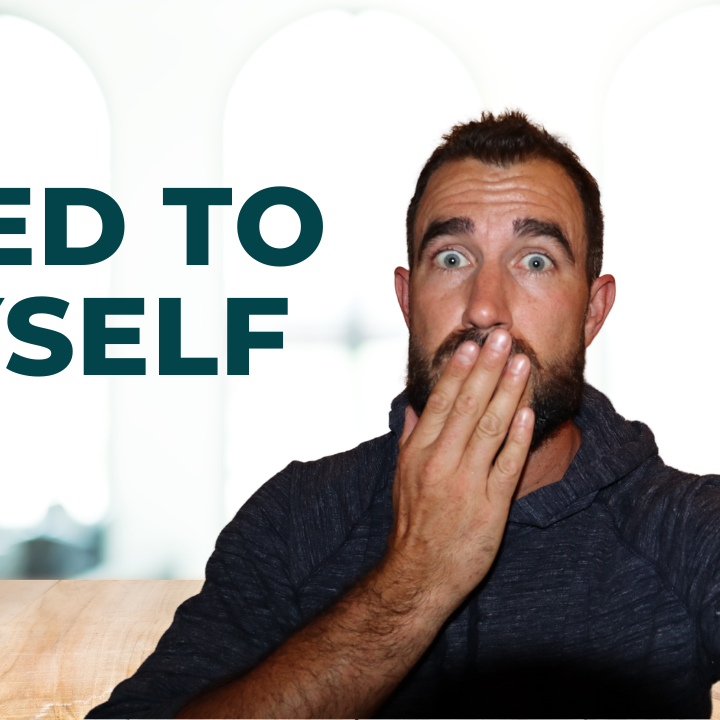
Background:
- Father
- Doctor of Chiropractic
- Owner of Live LOUD
- Personal Trainer & Health Coach
Check Out Some of Our Other Blog Posts and Podcast Episodes
Building Health & Fitness in your Life | EP 86
Health & Wellness,Fitness,Lifestyle
December 28, 2022
0 Comments61 Minutes
I Lied To Myself
[00:00:00] Dr. Antonio Gurule: What’s up guys? Welcome back to another episode of the Live Loud Life podcast. My name is Antonio, your host of the Live Loud Life podcast. Uh, I just wanna say, first of all, thank you for being here. Thank you for falling along on our journey. I hope that this information has been both informational, uh, and motivational to you, to helping you along your journey.
[00:00:17] Um, we don’t have, we don’t have a lot of housekeeping, A lot of, uh, a lot of introductory short talk. Be sure though to check out, uh, our website if you have not liveloudlife.com. We have a number of just different blog posts, resources out there that really just kind of expand upon the conversation that we provide here on the podcast.
[00:00:37] Uh, that being said, Our Instagram handle is @live.loud.life, and, uh, that’s a lot more of just short form content that, uh, you can take in little bite size. Uh, we talk, obviously our focus is families, right? And we do have a, a strong love for helping prenatal, postnatal population. And the, and the families and the kids along with that.
[00:01:01] Creating Generational Health
[00:01:01] Dr. Antonio Gurule: But we can’t forget about the dads. We can’t forget about the grandparents, um, and everybody else that’s involved in that family because what we’re trying to create here is generational health, right? The wisdom and knowledge around what healthy living is and how to live long, healthy life. That’s generational, right?
[00:01:19] It starts with grandparents passing down to parents, passing it down to their kids on and so forth. You can break the stigma or habits. That might be in, involved in your family and set, set your fu future generations up to live better, to live louder, to live longer. And that’s really what our focus is. So we obviously hit that in a number of different avenues and facets.
[00:01:46] Uh, while we are not specialists in everything, we try to bring specialists on to talk about certain topics. Uh, but what we, what we really focus on a lot of, Excuse me. It’s a lot of movement based stuff, right? Uh, having a background as personal trainers and strength conditioning coaches and mo mobility coaches, we help a lot with.
[00:02:07] Like, Hey, you’re in pain. And pain is a big de deter for motivation and momentum, right? So how can we help you in this, in Trump to continue on? And then from there, as you’re, as you, as you’re gaining momentum and rolling forward and living and living loud and living your life, How can we polish the edges?
[00:02:22] How can we take some information to maybe expand upon that? And that’s kind of the, that’s kind of the, the, the segue into what I wanna talk about today.
[00:02:34] How I’ve been Lying to Myself
[00:02:34] Dr. Antonio Gurule: Today’s today’s show topic is, I lied, I’ve lied to myself, I’ve been lying to myself. And that then creates a slippery slope of, of what I’m actually able.
[00:02:50] To produce what I’m able to or how I feel about certain things, um, you know, so on and so forth. So I’m gonna dive a little bit more into obviously what that means so that we can clarify that and why I am sharing this. So I hope you enjoy the show.
[00:03:15] All right. So lied. As I was stating, I’ve, I’ve been lying to myself. Now, this is where things I think get very interesting in the role of social media and. Individuals not, I wouldn’t wanna say finding validation, right? But oftentimes when we get stuck or something like that, we’re finding we’re, we’re reaching out, we’re looking for motivation, we’re looking for inspiration, we’re looking for ideas, we’re looking for information about others that have maybe been down this journey or this path before to figure out maybe how to get unstuck or, or get back on path.
[00:03:52] Um, or just a complete change. Like, let’s say I’m, I’m stuck with, uh, I don’t wanna be here anymore and I wanna be over there. And this is, this goes for any. Facet of life, um, finances, um, of career, um, how your, your, your body and your health, right. So this is not unanimous to just any one of those, those things.
[00:04:14] And, and, and I think that’s really important because we can’t do this on our own. And if there is someone who’s done it before you, they’ve obviously forged a path and understand that. So it’s good. Uh, they, as they say, success leaves trails, right, uh, of following the breadcrumbs of information to determine what’s best.
[00:04:35] But the hardest thing is then when you are doing it right, when you’re doing it as being honest with yourself about, um, more or less the efforts putting in, because you can’t really judge, You can’t really judge the results, right? Judging the results. Is is only a byproduct of the efforts put in. That’s just what it is.
[00:05:01] There are obviously extenuating circumstances that could change the results, but even then it’s like, what are you gonna do about it? Right? You can’t go back and change that. So it’s either then prepping yourself better for those random circumstances that might come up. Right. Or just forging forward again, and this is where I have not been honest with myself.
[00:05:26] There is, and, and I do, I do understand grace. I do understand forgiveness. I do understand, um, you know, reflection of giving credit. And, and, and, and being proud and, and excited of what we have accomplished. And I, and I am like, our life is wonderful. Um, you know, I, I am, I am extremely, extremely grateful for the opportunities that we’ve had, not only for our business, uh, my for my education, being in a, being in a place, uh, within the world and in the United States where, where that is and could be possible.
[00:06:04] Um, you know, being able to. Uh, being able to raise a family, being able to buy a house, I am extremely grateful for where we are. And it is one of those things, like, this is a funny thought. I, I honestly go back and forth. I go back and forth between, I. Watching and listening to inspirational, motivational type.
[00:06:30] I, I really enjoy doing that stuff. And it’s, uh, it, it is just something that, you know, motivates you and charges you. And, and I, and I love doing that. And I go through these waves and forms, right? But then on the flip side, I’m, I’ve been digging country music lately. I so funny growing up. I mean, my dad listened to like old school kind of country.
[00:06:50] And then I didn’t really listen to it too much, but now I honestly feel like the, the other side of that is like, there’s so much a part of me that’s like, You know, what do you need in life? Die a happy man. Family, food, roof over your house, type of thing, right? And there’s, So I’ve like, okay, on this side I’m getting amped.
[00:07:11] I’m, I’m psyched. I’m ready for that next level. I’m ready to do this, this, or this. And then like, sometimes I’m just like, Hey, I just wanna. I just wanna, I just wanna sit on the back porch and, and, and do X, y, and z and there’s a time and a place for both of those. And I think that’s what’s important of understanding where you’re giving your time and attention and, and carving out the time and attention to be able to get that other side out of it.
[00:07:33] Cuz it can’t be just go, go, go, go, go, go, go.
[00:07:39] It can’t , it can’t just be go, go, go, go, go. Um, and there are some people like that, God bless our souls, who can just, just rev and grind and just hit it hard all the time. And, but, but when you start getting, when things start kind of getting washed out, Right things, Things will start to get washed out when you’re not taking a consistent audit and being honest about the effort.
[00:08:01] Clearly Defining Goals to Drive Efforts
[00:08:01] Dr. Antonio Gurule: So when I’m talking about this, Go, go, go, go, go, go. It’s, this is, uh, let me rephrase this. It’s not Go, go, go. It’s, it’s being. Uh, specific, it’s being intentional, it’s being direct, it’s being clear about goals, aspirations, next level, whatever it might be, right? Because that helps you define the efforts that when you put in, and this is where again, I have struggled the most, is maybe not defining things as as clear, um, uh, which would be super helpful in certain facets, right?
[00:08:30] But being honest about the efforts I’ve been putting in, because when you start mixing all this stuff, you can’t do everything at once. There’s a great book called The One Thing, and that’s what’s so hard about being a business owner, a. Relatively young. So I mean, we’re not, we’re over the five year hump, but we’re not heading the 10 year hump.
[00:08:47] Uh, but having a family and having this, all this stuff is, you can’t do all the things. And when you try to start doing all the things, your efforts start getting diminished, um, in any one of those things. And then the effort, or sorry, the output and the results start to start to start to drop. And that’s just how it is.
[00:09:04] And, and yet then I say, you’re doing, you know, you’re doing good, you’re working hard, but I’m confusing. Oftentimes movement with moment or sorry, movement with actual progress. And that’s, that’s a harder thing to measure all the time, cuz the day in and day out grind, you’re not gonna see daily progress.
[00:09:20] It’s about being consistent and being honest about the consistency of the efforts that you’re putting. Right, And, and that’s what I encourage you guys to look back and audit in your life in different areas of life. Have you, if you’ve ever heard of the wellness wheel, right? You have some of examples and there’s different, there’s different.
[00:09:41] There’s different ones out there, right? But you have like business relationships, spirituality, health, um, uh, health, a subset or a different one. Could be like even like nutrition or something like that. But you start to look in, there’s like, and each one of those, there’s like really being honest with yourself and not lying.
[00:10:00] How, how, What are the efforts like grade yourself. If you wanna put a scale of one to 10, abc who cares? It doesn’t really matter, but grade yourself. Not where they stand necessarily, but uh, what I’m gonna start doing is grade myself on the ef the actual honest to god true effort that I’m putting in and the effort sometimes, like this is an example that’s hard to sometimes major, that right.
[00:10:28] But think about, this is like for the most part, for nutrition, it’s the effort of what you’re not obviously consuming, right? Most of us know we should be getting easier or more fruits, veggies, whole foods, meats on and so forth. But that takes more time and effort. So it’s a lot easier to just grab the bar to do this, right?
[00:10:49] It’s a lot easier to say, Hey, I’m a little tired. I’m gonna take, I’m gonna take my work out a little easier today. When in reality, It should. Its, I don’t wanna say that’s the lack of motivation, but we’re not doing anything that actually makes us that tired. Like we should be able to kind of dig deep and push ourselves a little bit.
[00:11:08] And, and this does, you know, we’re not confusing physiology. We obviously know the need for sleep. And this, there’s a, there’s a whole nother conversation that has, that has to be had around recovery, obviously. But I think so many of us we’re just, we’re just, we’re. Beat down to a certain degree from having all these other things that we need to do, and we’re just feeling too scattered.
[00:11:29] So having pen and paper, notebook, um, uh, uh, computer, whatever that is, and just trying to just start, start writing down and being more clear about those things and trying to find the patterns of, okay, I wanna need to allocate more time here. I need less of this. And in reality, when you start doing this, when you really just take a few minutes and start doing this, It all, it opens up pretty, pretty clearly, right?
[00:11:55] Releasing in Order to Move Forward
[00:11:55] Dr. Antonio Gurule: We, we tend to know the things that we need to stop giving so much time and effort towards, or maybe need to be a little bit more efficient towards, so on and so forth. And I always think about this. I was raised, uh, as I was growing up, I was Catholic. If any of you ever heard of Lent before, most people know what Lent is.
[00:12:12] But you give something up. Um, for Lent and, uh, it’s supposed to be a sacrifice. And more recently, I was thinking about this from a, from a, just a habitual thing, right? Obviously I have these, these goals and these accomplishments that I wanna hit in a number of different areas. and then I was just thinking, well, oftentimes we think about, well, what do I need to do in order to get to that, to get to those goals, to reach that marker, or whatever that is.
[00:12:46] And then, uh, it started then reflecting as well, what more than, what do I need to do? What do I need to let go of? What do I need to release? Because there are a number of things that are not aiding me or helping me actually get to those goals. And this was partially a reflection we had. Um, Uh, we were at a conference this past, this past weekend and, uh, one of the keynote speakers was essentially reflecting on, on the 80 20 rule, right?
[00:13:14] So the 80 20 rule, for those of you don’t know, is essentially that 80% of your results comes from 20% of your efforts, right? So if we were to break this down, Uh, let’s say, let’s say for instance, business wise, right? We do a lot of marketing and advertising, right? 80% of the revenue brought in from patients or whatever that is, comes from 20% of really what those marketing efforts are.
[00:13:43] So the goal is you gotta determine what that is so that you can double down and triple down or focus on that, right? But that, but it’s interesting, 80%. The, the 80% of our efforts only result only gives us 20% of our role results. Right? So it’s really. It’s, it, they, so it goes both ways, right? I need to understand what things I need to stop doing, but then the things that are working, that’s where you need to feed forward and in, and, and it’s a, it’s, it’s, it’s different for everything.
[00:14:10] It’s a constant reevaluation audit, as we had already indicated to, to figure out what those things are, because they’ll, they’ll change. Still change, like markets change as a result to business, right? Uh, seasons of life change. When you’re talking about, you know, if you get a, you have another kid, or you know, you move or works crazy, like how do you, how do you keep getting the results that you want, uh, uh, and making sure that you’re putting enough time and effort in the right.
[00:14:38] The right input, the, the 20% as opposed to putting more time and energy into the, to the 80%. So that’s been more of a reflection that I’m going through is not lying to myself and being honest. What are the 80 per, what’s the 80% that I’m still doing? That’s only, that’s only giving me 20% of my results.
[00:14:53] Cuz that’s the, that’s the fat that I need to trim off. And get rid of, and then that can focus on everything else. Right. And and most of us know, like when I was thinking about this, I knew right off the bat a few things that came to mind that, that, that just, just was, it’s not helpful, It’s not wrong, it’s not wrong, but it’s just not, it’s not like it was bad and it was creating negative results, like going backwards.
[00:15:17] It just was not helpful in the overall goal. And really, as you think about it, it’s kind of like, it’s, it’s, it’s slowing you down if you want to get to X, Y, and z. If you’re focusing or you’re doing too much of the 80% that’s only yielding 20% of the results, you’re just dragging dead weight. And there might be a time and effort where, a time and place where that might come back around and be advantageous.
[00:15:37] Return on Efforts May Include Support
[00:15:37] Dr. Antonio Gurule: But that’s what we’re trying to like dive in. And that’s why I’m such a big fan of, especially if we’re busy, we’re all busy. But, uh, I would call bang for your buck, right? When we’re talking about like movements, right? That’s why I’m so biased towards, um, things that, uh, have great impact with the littlest amount of E right?
[00:16:01] And for me, that’s kettlebells. Um, there’s, um, For me, it’s kettlebells. I think they’re, they’re great. They elicit, um, strength components if used appropriately. They obviously offer a lot of metabolic conditioning and cardiovascular training. Um, they can be utilized very effectively for mobility, training and stability as well.
[00:16:21] There are certain avenues that are, that you are missing out on it, but I think that’s one of the best bang for your buck, 20% that elicits a lot of the 80% or the results that most people are looking for. That’s a fantastic choice. That’s a little bit of a sidebar for this, but all in all, we gotta stop lying to ourselves, right?
[00:16:41] Creating a little bit more honesty. I, I don’t want you to beat yourself up, right? But it’s just, it’s just having an honest. An honest to God truthful reflection about where we are in certain things, and, sorry, more importantly, not where we are is the efforts that we’re putting towards that. If you’re not where you wanna be in some avenue of your life.
[00:17:05] Reflect back on the efforts that you’ve actually been putting through there. Now, if you feel honest and truthfully that you have been putting in as much effort as you possibly can, well, there’s ways to accelerate that, right? We have catalysts, uh, Support groups, coaching probably the easiest, Right?
[00:17:25] Mentors, whatever that might be. Someone that can help you figure out like maybe we’re just blind to the 80 20 role and we’re not quite sure. Right? And someone else can come in and be like, This is, this is the issue right there. So sometimes you just need a little bit of extra help to help you break through.
[00:17:42] But more times than not, you get a ton out of just doing this self reflection and audit and figuring out what to trim out. So hopefully this was helpful for you guys. Um, I’m gonna, this is, this is the transition and the change that I, again, this I’m just sharing my journey and what I’m gonna be focusing on, um, in this, this third quarter, sorry, fourth quarter.
[00:18:02] I’m 2022. Um, getting into 2023 and just kind of really prepping what this next year looks like as we’re winding down 2022, wrapping up a few projects, but then looking forward in a six months, one year, kind of three year point in time and, and doing some, um, some. Uh, some back, back casting to figure out what I actually need to focus my time and tension on and what I need to take my time and tension away from.
[00:18:34] So until next time, guys, live loud.
–
First Trimester Woes & Remedies with Baby #4
Live LOUD Life Podcast
Lafayette Colorado
Episode 82
First Trimester Woes & Remedies with Baby #4
With Dr. Antonio Gurule
In this Episode of the Live Loud Life Podcast, Dr. Nichelle shares her experience the early stages of her fourth pregnancy, throughout her first trimester. In addition to book recommendations and other resources, Dr. Michelle discusses the shared experience many people have in first processing their pregnancies and the mental and emotional dynamics that play into each choice that is made. Then Dr. Michelle shares personal remedies she has used to alleviate pregnancy related symptoms and pain points as her pregnancy progresses and body continues to transform while accommodating the needs of her growing baby while managing her toddlers tandem nursing routine.
EPISODE HIGHLIGHTS:
- [01:36] Understanding the Whole Reproductive Cycle
- [02:48] The Fifth Vital Sign
- [03:54] Fertility and Cycle Expert – Dr. Deb Merin
- [05:13] Processing the Big New of Baby Number 4
- [09:20] How We Announce Baby 4 to our Friend and Family
- [10:17] First Trimester Symptoms
- [11:24] My Tandem Nursing Experience
- [12:46] Remedies for my First Trimester Woes
- [16:33] Chiropractic Adjustments for Pregnancy Symptoms
- [23:02] Leaning into the Pregnancy
About Dr. Nichelle Gurule
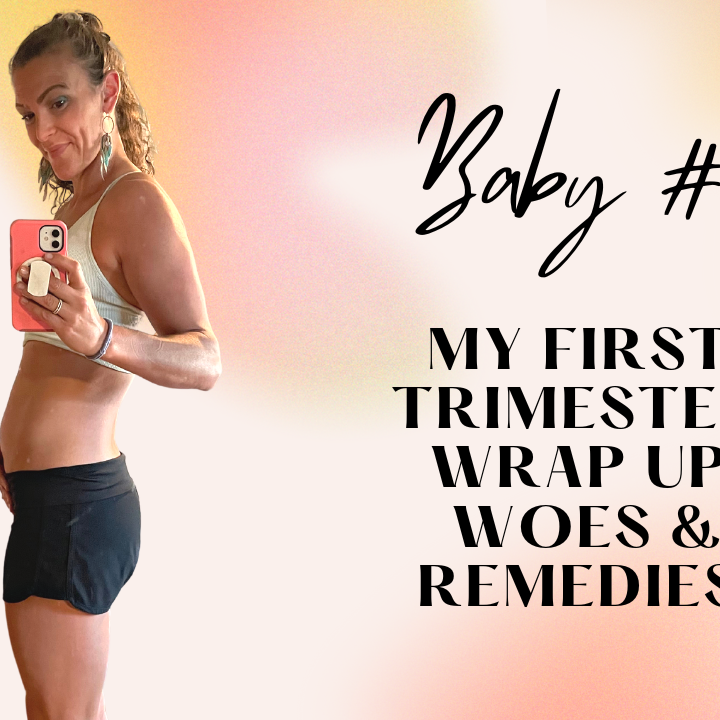
Background:
- Mother
- Doctor of Chiropractic
- Owner of Live LOUD
- Personal Trainer & Health Coach
Check Out Some of Our Other Blog Posts and Podcast Episodes
Baby #4 First Trimester Woes & Remedies
[00:00:00] Dr. Michelle Gurule: Hey, Michelle here, and I decided that with my fourth pregnancy, I am going to do my best since I am busy with three other children in homeschooling and. Being a chiropractor and online course creator and all these things, and being tired in pregnancy, that I would like to document a little bit of my own journey, which I am now outta the first trimester and I have more energy, um, that I’m hoping that I can do this more consistently.
[00:00:38] So, um, this is a little bit of a blog slash I’m on Instagram live right now. We’re all posted as well underneath my page. And so this intention is just to give you an idea and. To what pregnancy can look like during the different stages and what it’s looking like for me, cuz everyone’s journey’s gonna look so, so, so different.
[00:00:56] So, um, I’m gonna start going into second trimester in my next blog, but I’m going to be focusing on what just happened in first trimester because this is my fourth time and. My goodness. Like it still comes as a shock as to how exhausted I am and I feel like most people feel at least that exhaustion symptom.
[00:01:19] So a lot of people may not feel nausea. Yay, lucky them. Um, they may not feel some of the other symptoms that I’m gonna go through, but most people do feel that just extreme fatigue, just like what? I just got hit by a bus. I’m so tired. So, Let’s start off with first trimester in that the first two weeks of quotes, pregnancy, you’re not actually pregnant, right?
[00:01:40] That is your first part of your cycle before ovulation when you get pregnant, but it counts on tax onto your, uh, Overall time, if you will. Um, so first trimester, some people find out right away cuz they’re tracking and they just have this beautiful body intuition of, I’m pretty sure I just got pregnant on the ovulation cycle.
[00:02:00] Or they know exactly when they ovulate, they know exactly what side they ovulate on. And they’ll just know they’re pregnant. And then some wait for their period to come cuz they’ve been trying. Then period doesn’t come when it should. And then they wait a few more days and then they check with the pregnancy test.
[00:02:15] Um, and then some people it’s a complete shock. They find out weeks and weeks later when they’re like, My period should have come a while ago. So for me, this um, is our fourth kiddo and I had a pretty big suspicion that I was pregnant. I did have an intuition cause I was tracking my cycles as to. Which side I ovulated on and the sensation that I felt along with, if you track your cycle, which I highly encourage at some point doing because it’s really, uh, empowering to know, um, when you ovulate and you can check that in a lot of different ways.
[00:02:48] So there’s a book called, um, The Fifth Vital Sign. I’m spacing on the author’s name. I think it’s Lisa somebody. Um, I can put it in the comments later, which is a phenomenal book. I think every female and even male should read it cuz it goes through. All of the things about your cycle. And the fifth vital sign is essentially that your cycle, your period, your whole like 28 to 35 days tells you a lot.
[00:03:09] If it’s too long, too short, you’re bleeding heavy. Bleeding light tells you a lot about it, but it also goes into uh, how to track your cycle and know where you’re at. And there’s also another book called Taking Charge Your Fertility. That’s also really. Same kind of page with that information. So you can check your cervical fluid, you can check your cervix position, you can check your cervix.
[00:03:32] Um, how soft it is, how hard it is, um, open or closed. There’s all these things you can check. Of course you’ll have heard about checking temperature temperatures. Interesting because it gives you an idea if you’re tracking multiple cycles as to when you ovulate it, but it’s information after, so it’s not really the only thing you should rely on until you’re getting consistent cycles and there’s so many fertility.
[00:03:53] Like classes out there that you could take and do and learn? Um, my, one of my best friends, um, she’s in Chi, she was in chiropractic school with me. Um, her name’s, uh, Dr. Deb Merin. She has a course that teaches like patients or even, you know, anybody layman who wanna learn about their cycle, um, to learn more about this.
[00:04:12] So she’s a great. Uh, her Instagram handle is Coronado chiropractor, where you can learn, uh, more about that fertility information. There’s a great Instagram handle called, uh, I think it’s Fertility Friday. Um, and so there’s just a lot of resources where you can be empowered to know your own body, and so if it grosses anybody out to hear cervical fluid, You should really question yourself, Like, why does that gross you out?
[00:04:34] Because it tells you quite a bit about what’s going on. And I truly believe that if more women were aware of this, then they would be able to not get pregnant, or it would really help them be able to get pregnant. And, um, taking charge of your fertility and the fifth vital sign really helps with that. So first off, like I said, people are gonna find out different points in time when they’re pregnant.
[00:04:52] So I had some, some suspicions. A couple days after I missed my period and kind of sat on it, sat on it, and just really, um, before I talked to my partner, was like, Okay, how do I feel about this? Because I need to process this before I ask somebody else to process this, Right? So, found. Pretty sure that I was pregnant.
[00:05:13] So I mentioned to my husband Antonio, like, Hey, I think this is what’s going on. I think that I’m pregnant again. Um, to which I did one a fourth kiddo. So this is not a bad thing in any way, shape or form. I did want four kids. Um, but it was like, whoa, okay, this like might actually be happening. And wow, this is a lot cuz we had just moved into our new house and just a lot going on with the property.
[00:05:36] And so that can be a lot of shock to some people is like finding out. It can be a shock in a oh crap way and it can be a shock and like a yay way. But either way it’s a lot to process. So some people will process it first, tell their partner maybe they’ve taken a test. I processed it, then said I think we need to take a test.
[00:05:54] Then took a test and we looked at it together and was like, okay, guess we’re doing this. Um, and then there comes the next thing of like, okay, so maybe you find out in, you’re four weeks pregnant, so you are. Right around the time of your period is missed and you’re about four weeks at that point, cuz you have the two weeks prior to ovulation and then you have your, um, two weeks that you’re pregnant before you’re missed, period.
[00:06:18] So people are finding out between four and six weeks commonly. And that’s usually a zone where most people aren’t feeling sick yet. They’re not having a lot of the symptoms. Some people will, but there’s not a ton of breast tenderness quite yet. There’s not the nausea quite yet. They’re in this like in between spot.
[00:06:34] So, You’re thinking now, Okay, find out in four weeks. When do I announce? And so a lot of people hear the, I’m gonna announce at 12 weeks or 13 weeks when I am into my second trimester. Placenta is well formed. A lot of the chso issues and, um, common issues with miscarriage will have happened before then.
[00:06:54] Not always, but will happen before then. And so then it’s a safe time to tell people, well, for some like. The 13 weeks is a long time to sit on a secret if you feel like it’s a secret and it’s not anybody’s news but yours. Um, but for me, I don’t like sitting on that. I’m like, I have patience on cha on chat with every day.
[00:07:12] I am a chatty Cathy. I’ve got close friends. I got family. Like, it just seems weird for me to wait that long. So as soon as we found out, we knew, we wanted to make sure both of our families knew. And we wanted our kids to know before them, but the kids see the families all the time. So we had a kind. Tell them and then know we’re gonna tell both families right after that.
[00:07:35] And then once we did that, we were happy with anybody knowing. So the reason why I let people wait is because if you happen to have a miscarriage, everyone you just announced it to on Instagram or all the friends you told, They might still be checking out on you, How’s pregnancy, how’s this and that? And then it’s a lot to then tell them like, Oh, you know, we actually had a miscarriage.
[00:07:54] And you know, there’s a lot of people now who are being really open about their miscarriages because it’s really common. I think it’s something like one in four might even be more common. So, um, it, it’s just, it’s, it’s a topic that should be discussed, but it may be not be something that you wanna discuss with everybody.
[00:08:09] So it’s really a matter of you tell the people who you feel okay telling. If you were to have a loss, that’s the really one of the bigger things about it. So finding out shock in a great or bad way depending on what thing going on in your life. And then when do you announce is gonna be a big thing, and that’s gonna be totally family and person dependent on what things look like.
[00:08:30] And then who do you announce to? Do you wanna do a big. Seen on Instagram or you know, a big party or do you just wanna tell your close friends? And there’s nothing wrong with either way, right? It’s just what goes on for you and then how do you announce it, right? So, um, first kid, you know, sometimes you’re like, come do something really cute and like let them know in a cute way.
[00:08:49] Um, and then, you know, it changes each kid. So for us, um, for our families, we didn’t do anything like super grandiose this time. We basically just had the kids say, Guess what? We have a surprise for you. And then t is our third kiddo and we. Tage is gonna be a big brother. And they’re like, Wait, wait. Oh, oh.
[00:09:06] Um, so there’s so many different ways you can take pictures. You can have them wear a shirt that says, I’m a big brother. You can have so many things you can just, you know, have a card that has an ultrasound in it, but there’s so many different ways you can do it. And then we had a fun post because of our new farm property that we just said.
[00:09:20] We made a sign that said One more set of farm hands. We had our barn in the background and all the animals and things like that. To announce to like the Instagram world and just a cute picture. Um, so let’s talk about first trimester because it is a whirlwind, which is honestly why I have not come on here and do done this vlog and live yet because I’ve wanted to.
[00:09:38] And then it’s just like, it’s just like too much to handle. It’s like way too much so, Uh, because you’re just too tired. So, like I mentioned, I have a chiropractic practice with Antonio. I have an online course, I’m building an online course, uh, like company with my friend, uh, Katie Braswell and. It’s just like one of those things that’s like, I, I’m too tired with that.
[00:10:02] And then having three other kids and homeschooling and doing all this work on our, our, our new property that’s an acre. It’s just, it’s been a lot. So, uh, but I do think it’s important to share what’s going on with each person because it helps people feel less alone, get ideas as to what you can do for certain symptoms.
[00:10:17] So I’m gonna tell you some of my symptoms and what I have done for. Um, and then also just like I’m coming from the perspective of this is my fourth time around, so everything, I feel like the first time was just so much more like, ugh, this and that. And I know like when things are gonna end for me and I know how things go, and so it’s, no, none of this is a shock for me.
[00:10:37] I don’t have the nuance of it being the first time I’m becoming a mom on top of all these other things. So, The first symptom, like I mentioned, is being tired, and so one thing that I was able to really let go of with subsequent PR pregnancies after my first is just being okay with taking naps and being okay with going to bed at 7:00 PM or 8:00 PM and just not feeling bad about it.
[00:10:59] Now I do just if anyone knows me, love being productive and efficient and just getting stuff done, and that is the part that I’ve had to like dig deep and be like, It is okay. It’s okay. Being tired, letting myself take those naps because I know it’ll go away. But each time I forget how stinking exhausting it is, how tired it is in first trimester.
[00:11:24] Um, another big symptom is starting to have breasts that are like getting fuller again. So I was breastfeeding the whole time. So, um, my two and a year old is still breastfeeding. Symptoms have been fine until actually the past two weeks, which is the start of my second trimester, which is showing me there’s a hormone shift.
[00:11:41] And then it’s been a little uncomfortable, but he, he’s still getting milk. I’m still nursing him because he wants it morning and night, sometimes around nap time. Um, I’m happy to answer any tandem nursing questions, pregnancy, nursing questions cuz there’s a lot that comes along and I’ve now nursed through this will.
[00:11:56] Third pregnancy I’ve nursed through, so I’m happy to share that. Um, I’ve had a two year old on one breast and a newborn on the other. I don’t know what it’ll look like this time. Each journey is different, but I’ve basically breast fed for seven years. So it’s interesting because breast size goes down over the course of time.
[00:12:11] Breasts start kind of sagging a little bit. They’re no longer full, and then suddenly they’re like full and lifted again, which is interesting to see again. And then they’re starting to be tender as well. So that’s a symptom. Nausea and vomiting. So luckily this time I’ve only thrown up a couple times and.
[00:12:27] It does actually end up making me feel a little bit better, but it sucks. Like no one wants stuff to throw up and the nausea is just a bummer because it’s just like, you wanna enjoy food? No food sounds good. Like, you know, you needed something. And this time I had like some really bad like stomach cramping, um, where I was like, I wanna eat, but it hurts and it’s like cramping.
[00:12:46] And it was not just nausea. So that was really uncomfortable, but different this time is that I had, um, nausea from. Six, seven weeks until 11 weeks with only intermittent days of nausea and I can’t figure out why. Cuz the other three pregnancies, I was sick until about 18 weeks. Um, Throwing up a lot, and I do have a suspicion that because I’ve gone a different route this time with my supplementation for pregnancy, I’ve actually chosen not to do a prenatal, which sometimes I’ll still recommend for patients because that’s easier for them.
[00:13:19] But I’ve gone more of like the whole foods route and done like beef liver. Cod liver oil, Um, an ionic magnesium. Really focused on making sure I’m eating eggs every day, really tuning in to those types of foods. Um, I think might have been what’s helped my nausea also, what been really conscious of making sure I’m eating consistent meals to keep my glucose balanced and eating, making sure I’m eating a good amount of protein.
[00:13:45] So I think that even though I knew some of this stuff before, I did some slightly different. Ways of doing it, and that’s the only thing I can figure that is making that different for me, or it’s just a different baby and it likes me more. I don’t know. Um, One thing that’s frustrating that I’ve found is that like food is all over the place.
[00:14:03] So, um, I eat really healthy in my everyday life and I’m eating things like salads for lunch and definitely eggs every morning and like amazing veggies at night. And it’s like, do not give me a salad during first trimester. I probably don’t want very many veggies. I’m gonna try to eat them, but like, ugh, like they’re not gonna digest and be great.
[00:14:22] I want carbs and I want. I don’t wanna say shitty foods. I don’t like to call food bad or good, but like I wanted french fries this time and in the past I’ve wanted like sub sandwiches or pizza. And I’m not saying those things are bad, but it’s like all I want type thing. Um, and it’s the only thing that’ll get my stomach to settle.
[00:14:37] Like why would like fast food french fries be the only thing that makes my stomach not feel nauseous, but like a beautiful meal would not, It’s just, it blows my mind every single time. For me, I have to let go of that and be like, It is fine. First trimester. Not trying to be a hero here. This is just when I need to accept that I ate really well prior to pregnancy.
[00:14:58] I was, I’ve been still able to take the, the way that I’ve chosen to, in quotes, like supplement, um, and. Make sure I have all those beautiful like foods added in and just be okay that I can’t get all the veggies I want, or exact levels of protein and carbs and just eat right. And just trying to be not nauseous, essentially.
[00:15:18] So it’d be like one day, it’d be like chicken noodle soup is all like all the, it seems like it can settle. And so then like Antonio makes a bunch of chicken noodle soup and then it’s kind of like, I don’t really want that anymore. And the next day I. I can’t even think right now, but like, you know, some other type of soup or I want some other type of food and it’s like, Ooh, I want this as a snack.
[00:15:34] And the next day different type of snack and it’s like just food is all over what sounds good. And so just leaning into that. So I lean into just whatever feels good. So for nausea, I’d suggest try to keep your blood sugar as balanced as you can. Making sure you’re getting protein, even if it means like maybe you just got a spoonful of like peanut butter or almond butter.
[00:15:53] Um, or you know, maybe you don’t need a ton of dairy normally, but adding in like a raw cheese might be helpful. Um, and trying not to have naked carbs. So if you’re like, I have to have crackers okay. At the crackers, but see if your body’s okay with adding cheese to them. Or some other protein, or if you can do avocado, like does that work for you?
[00:16:11] Um, and just plain with different ideas. Um, one, something that really has bothered me during this pregnancy has been constipation. Got really bad actually. I feel like the worst it’s been. And I, I was doing so many different suggestions with teas that people had. Of course, the magnesium increasing my water, you know, I knew I just wasn’t gonna have a hard time with increasing the veggies, so that was challenging.
[00:16:33] Um, and one day I had been like four days, which is like not good like I was supposed to, doing an n. Um, I hadn’t gone to the bathroom. I just could feel it. Like I’d said so much in my like, intestines. Uh, my mom even said like, Oh, I can see the baby bump now. I was like, No, it’s not even the baby bump yet.
[00:16:50] It’s straight up like bloat in that I haven’t gone to the bathroom. It’s like, you’re supposed to poop every day, you know? And I do, and I just couldn’t this time. Um, so I actually been having, starting to have some sacral stuff going on. I kept forgetting, having Tony adjust me, and finally I was like, Okay, can you adjust me this morning?
[00:17:06] Kid you not after four days and trying all the magnesium and upping all the things, he adjusted my sacrum. And then upper cervical as well, which are two areas that make babies poop a lot. Um, when I’m working on them and. I would do a bathroom like two minutes later and it was great. And then that day, like four other times.
[00:17:22] So chiropractic truly affects the nervous system. It can get bowels moving for sure. I can really attest to that. A lot of my baby’s gonna attest to that as well. Um, and then one other suggestion that I actually got from a doula that used to be my area, Alyssa Mcgi. Um, her Instagram handle, I think is at St.
[00:17:40] Augustine. Doula I think is what it’s, But she suggested a couple different teas to me and then she also suggests to eat raisins throughout the day. So I’ve been eating raisins throughout the day cause we had ’em anyways. And I actually think that that with chiropractic has been really helpful for my body cuz I haven’t increased my magnesium.
[00:17:56] But it could also be a hormonal shift cuz now I’m in second trimesters. So that is a suggestion that I would’ve never thought of before because you hear like prune juice and things like that. But I’ve just been chewing, not a time, but a little raisins throughout the day. And that seems to. Helpful. And it’s like a, a lot of times I’m like, Why do I want like gummy bears during pregnancy?
[00:18:14] I want some of these sugary gummy bears, but the raisins have like, made me not feel the need for that. Um, let’s see, uh, other symptoms, So pregnancy rhinitis, which is where you can just get super, like just congested. There’s more mucus and fluids during pregnancy and um, a lot of, um, congestion inflammation can happen from that.
[00:18:35] There’s really only if it’s not allergies, which I also have allergies into the mix of this, which, um, course 10 has helped me a lot with allergies. And then I have a homeopathic, uh, remedy that I’ve used as well that has been helpful but hasn’t seemed to be able to hit the allergies that are out here in Colorado right now.
[00:18:52] But two things that are really helpful, um, that I’ve found to help me breathe at night so I’m not mouth breathing cuz then you wake up with a sore throat and like, you don’t wanna mouth breath, you don’t wanna be a mouth breather. That’s not great. And I’m not classically, but my nose has been really stuck from this pregnancy rhinitis, um, is.
[00:19:08] There’s the breath right strips, which I just have an off brand nasal strips. But the problem with this is it actually helps really well like lifting up and helping like open that nasal passage but you can’t wear too many days in a row or like makes this skin really sensitive. And I ended up having like a little piece of skin get so sensitive, like peeled off and I was like, Ow.
[00:19:25] So this little like sc for a little bit. So I then I was like, I don’t wanna wear those for a couple days. So then I got these really cute and sexy antis snoring nose vents and I don’t believe I was. Snoring. We got these off Amazon and this is what they look like, and you put ’em up your nose and it opens and, and allows you to breathe.
[00:19:42] So that’s been helpful for me as well. Um, Amazon, they come in in 12. I’m like, I don’t need 12 of these, but I have 12. Um, and that’s helped a lot. And then, As a chiropractor, I do hate admitting this cuz it definitely can crank on the neck a little bit. I’ve done like a slight, ever so slight incline just so that I’m not flat laying back.
[00:20:00] Um, so I’ve done a little slight incline, but I’ve been really aware of the angle to help with my neck. And then I live with a chiropractor so it can help my neck. Um, but I’d rather breathe at night cuz that’s really, I notice that if I’m not breathing well through my nose it increases my nausea. Um, and it just makes me feel more fatigued cause I’m just like, I’m like heavy breathing.
[00:20:17] So something to consider there is, If you’re not breathing well, that could be impacting these other symptoms. Like breath is really important. Making sure you have nice good breathing. Oxygen flow is really important. And then, uh, a neti pot is really helpful as well. And you can make your own salt and baking soda solutions.
[00:20:35] Um, but that doesn’t always cut it either. So kind of a combination I’ve had to flow through. Um, other thing, during pregnancy, I am hypermobile, so I screen all my patients to the bait and scale, seeing if they’re hyper mobile because hyper mobile patients I’ve found. More likely to have pubic bone pain and si pain during pregnancy.
[00:20:53] And I am hypermobile. I have not been working out as much and doing stability exercises, so then I added them back in cuz I know what I need to do. Um, I’m just tired and it’s hard to do it. So it really helps me reminders like, relate to your patients. This is how they feel too. Um, but that sacred. Um, I’ve been feeling at night, so I have to shift a little bit more, and I’ve already had to add in a sleeping pillow, add in my stability exercises, so things like glute bridges, squats, uh, possibly cla shells, um, lateral walks.
[00:21:25] And when I add those in and just strengthen my glute muscles and hip stability muscles, that really helps with the sac issues a lot. And I haven’t had them during the day, but the fact that they’ve been sneaking in at night is let me know, like, Okay, really time to do these things. So, I love people to come in and see me to do the chiropractic and rehab work before they’re in pain, um, so that we can get ahead of things so that they’re not in pain during pregnancy and at the start of anything come in so that we can help you.
[00:21:49] Um, then there’s also, so actually I wanna touch note on that is that like I have fitness as part of my life. It’s part of my identity, but as I mentioned, one of my first symptoms, a lot of people feels tired. I have to let go of that. Life is just a little bit different in first trimester. Working out is really just not high on my agenda.
[00:22:07] I’m tired. I have so many other things to do that I let myself. Be okay with not working out. And I’ll do my rehab. I’ll fit in a few squats. I do a lot of yard work and I’m like, I’m moving. That’s what I want is movement. It is okay if I’m not working out. During first trimester, I really was fitting in walks, again, yard work.
[00:22:27] So I encourage patients, can you fit in a few strength things just to help stability. So maybe just a few glute bridges, a few squats. Can you go on some short walks just to get outside and get a little bit of movement. But in terms of going to Orange Theory or CrossFit, your HIT training or going on runs, if you don’t feel like it, lean into that and be okay with it, you will get back into it.
[00:22:47] And I already feel myself getting back into it now that like I’m getting my energy back and I’m feeling better. I’m not nauseous, but when you’re nauseous, you’re not gonna go for a run or lift weights. Like it doesn’t feel good. And there are studies that say the exercise can reduce nausea. It never did for me.
[00:23:02] So fourth pregnancy, I’m like, I’m just leaning into, I’m not working out right now. And that is okay. I’ll get back into it. And so that is what I’m getting back into in second trimester. Um, so first trimester sleep struggles can also start. So I’ve found some nights I’m like waking up every other hour. Um, magnesium can really help with that.
[00:23:20] Um, and working out can actually help with that quite a bit too for me. Um, so once I start working out again, it really helps, uh, getting into deeper sleep. Um, and then, let’s see. Oh, the last thing I wanna mention and then I’ll stop here, is that one of the hardest parts for first trimester for me is not feeling like I’m being productive, which I had mentioned already, and that’s really hard for me within the family because it’s like, I don’t wanna cook meals cuz I’m nauseous and I’m tired and I, you know, I was like making bread all the time.
[00:23:51] I didn’t wanna do that for the family. It’s like, oh, going out and helping with the chickens and ducks. Like, no thanks, like I’m too tired and helping get the kids to bed. Tired and don’t feel good, and just like not contributing the way that I wanna contribute doesn’t feel good for me. Um, and then in the bi in my businesses, it’s tough to just be like, I, like not like I’m gonna go to bed
[00:24:11] I’m like, I have emails to send out, I have notes to do. I have all these things to do to get going on another online course that I’m doing. It’s like, just can’t. Um, and then I could feel my energy ramp back up around like 13 weeks where I’m like, Yes, get this done. Get that done. I knew it would be temporary, but in first trimester, if you are not feeling productive or efficient or feeling like, man, like your partner’s having to carry so much of the load because you don’t wanna cook and you don’t wanna like, help the kids get to better, whatever it is, like, it’s okay.
[00:24:42] It, it won’t last forever. Your fatigue and exhaustion is real. Your nausea is real, and like no one expects you to be a superhero at this point in time. And so that’s also me speaking to myself like it’s okay. And I will say it did take at least a full pregnancy, maybe two for me to be okay with that.
[00:25:01] This is my journey. Um, I added just extra stuff to it, but those are some of the main symptoms that I’ve had. Um, Bloating’s another one. So a lot of us will feel like super flat stomach in the morning. At night. You’re like, Am I eight months pregnant? What’s going on? Um, so bloats really normal. It can be uncomfortable.
[00:25:18] I spend a lot of time because of the constipation and bloat in first trimester, already starting to add belly oil. So I really like wish gardens belly oil. I have this in the office and so I just rub this on at night. I rub into my muscles. Um, I note where my uterus is. So, um, you know, by, 10, 12 weeks, it’s reached past the pubic bone.
[00:25:39] So then I start feeling for it. It’s a little hard, and then I kind of watch and observe and feel it grow up and just feel that like I’m like, This feels hard. Oh this, that’s like my uterus. And feel those shifts and changes in my belly. And it’s a really great way to connect before. The baby’s moving. Um, and then just starting early with the oils and nourishing that skin, that’s gonna go through a lot.
[00:26:00] Um, and then I’m just in the habit of, I’ve just massaged my belly at night and I do that every night during pregnancy. Um, and it feels great and it’s really helpful to keep your abdominal wall muscles, um, just like. Loose and pliable and not like super tight and tense. And I did a lot of wheelbarrow like, like dig like bunch of dirt into the wheelbarrow and like lifted it and moved it over here and did a ton of loads and I noticed that.
[00:26:24] So I have like a trigger point in my abdominal wall. And so I don’t want that trigger point to get worse and worse that it’s an extreme pain as things start like expanding. So it’s like I grab this oil. Then I got all over my belly and was digging in and, and working on that. So, um, just a few things. My first trimester, next time I do a live in a blog, I’m gonna come on and talk more specifically about what I’m doing each week or every other week and dive into the movement.
[00:26:47] I’m doing symptoms I have. Um, the rest of it will be shorter, but this has been like encompassing all a first trimester for myself. Um, letting you feel like you can give yourself some forgiveness if you’re not doing a lot right now. Um, and if you have any questions, just reach out to me, cause I’m happy to answer those pregnancy questions.
[00:27:04] All right, Bye you guys.
–
